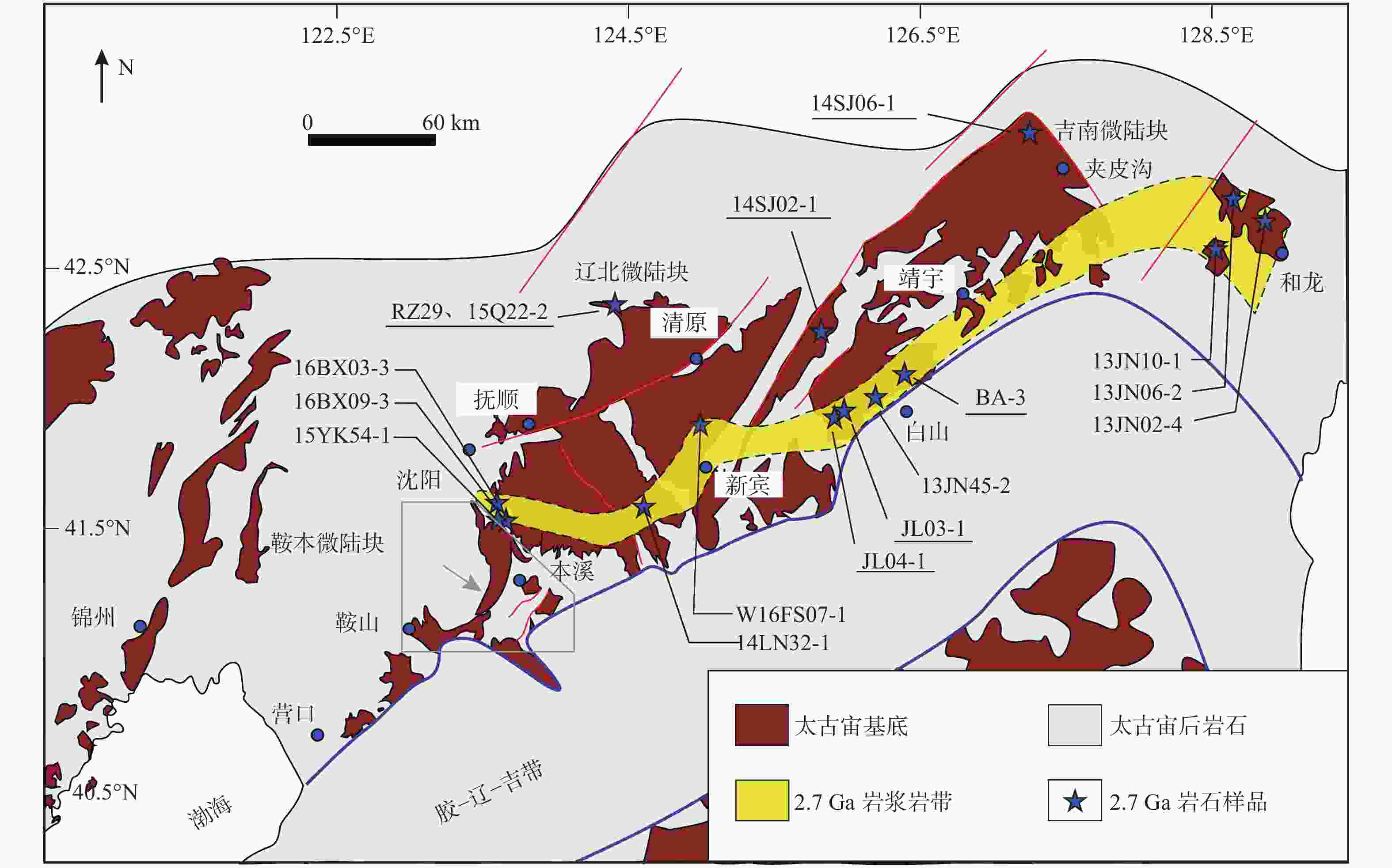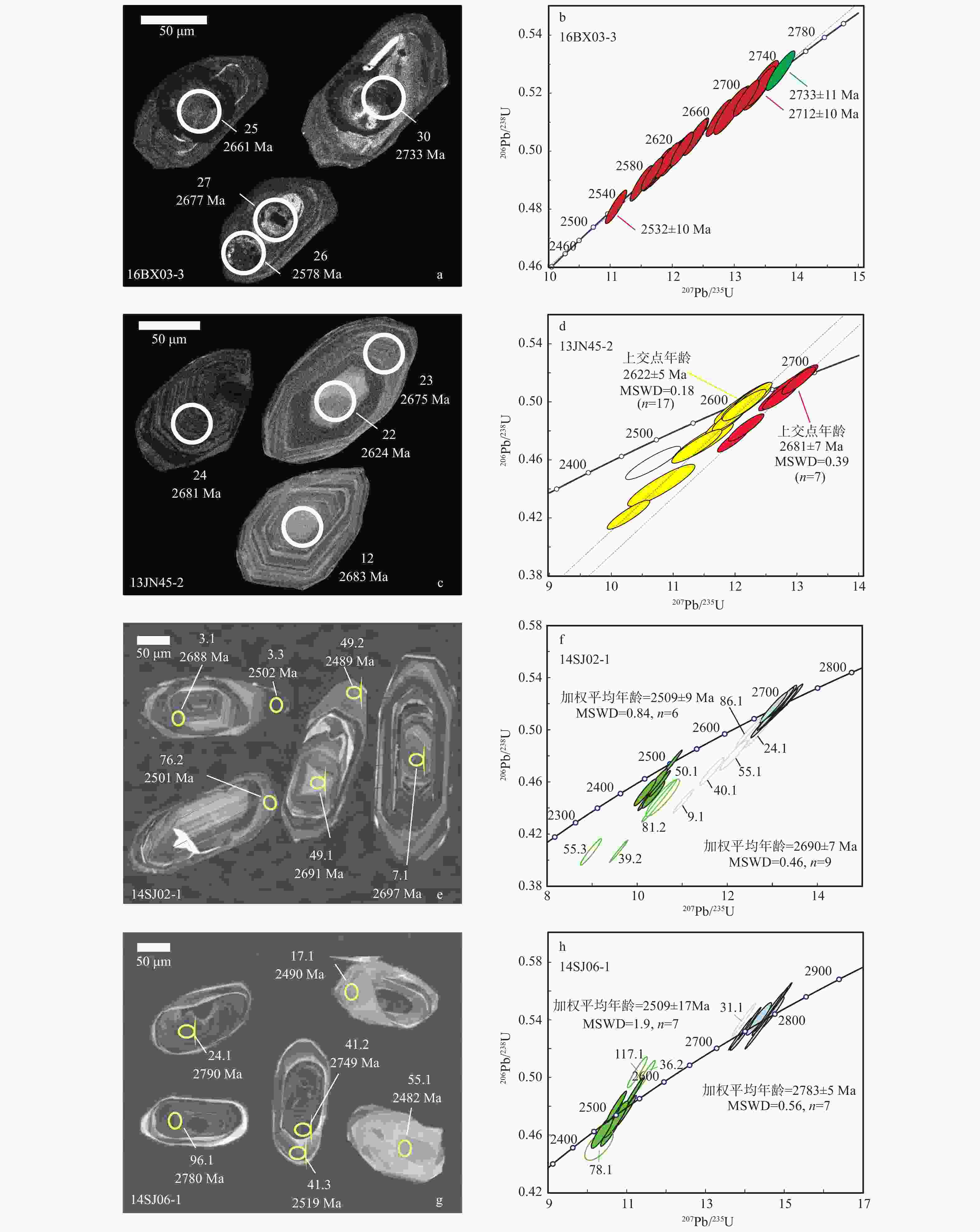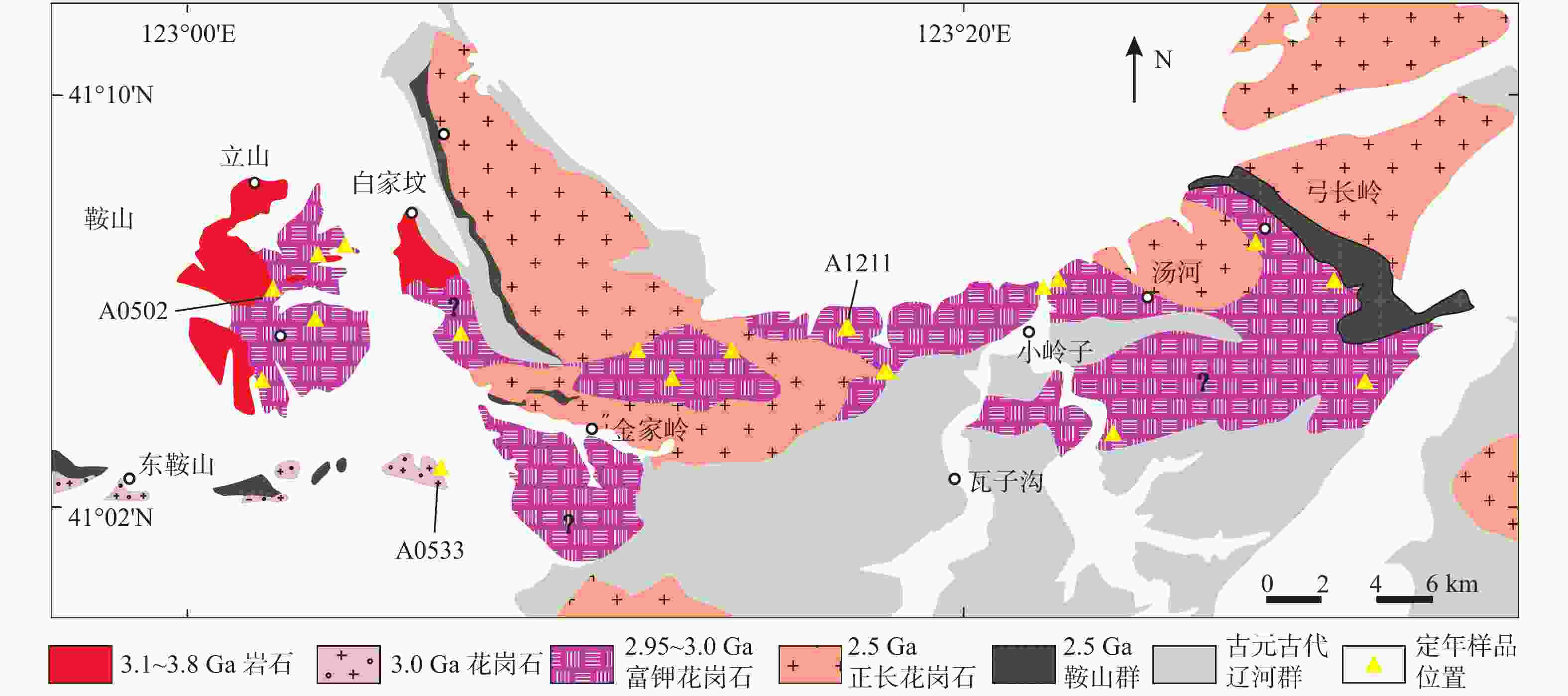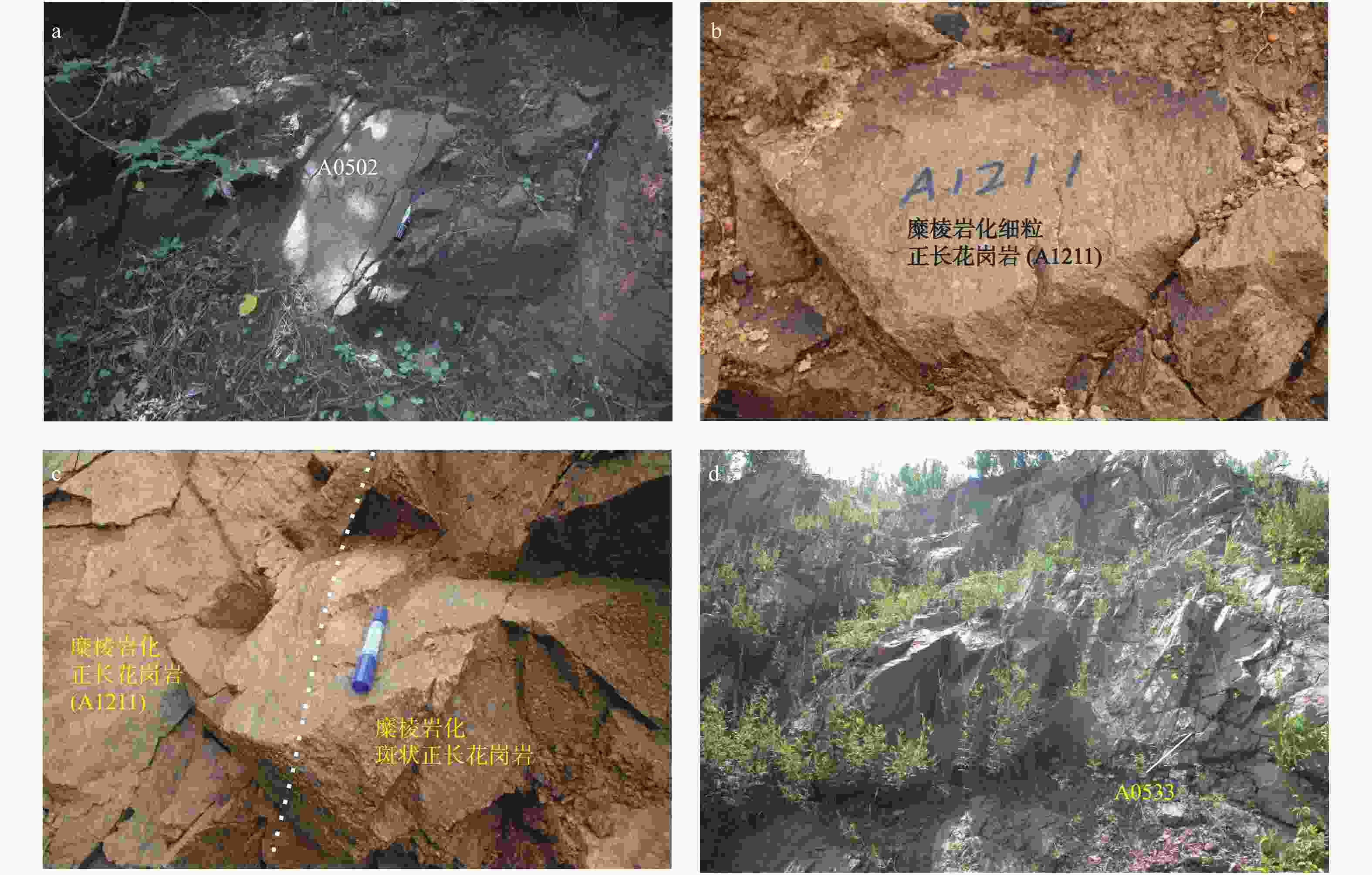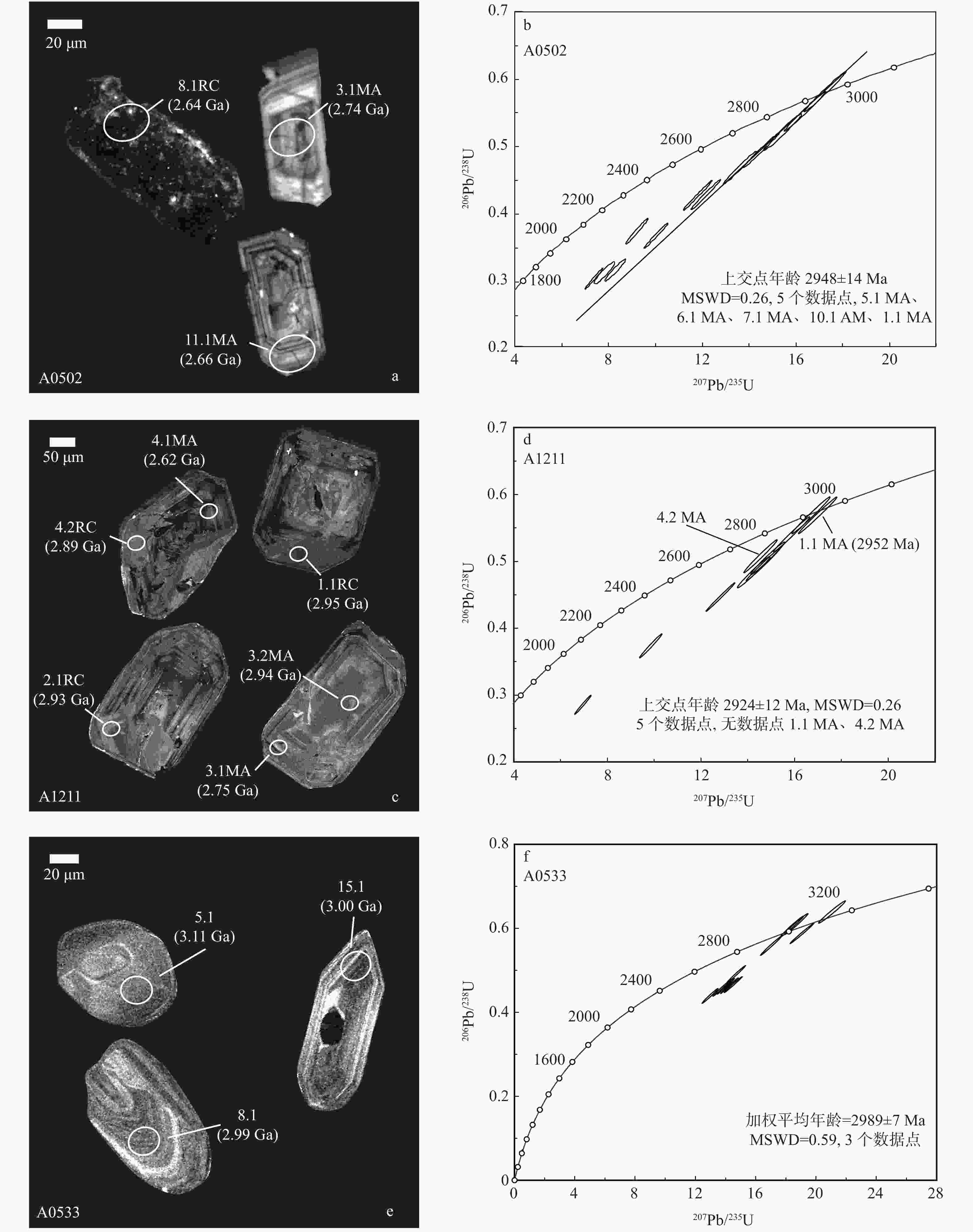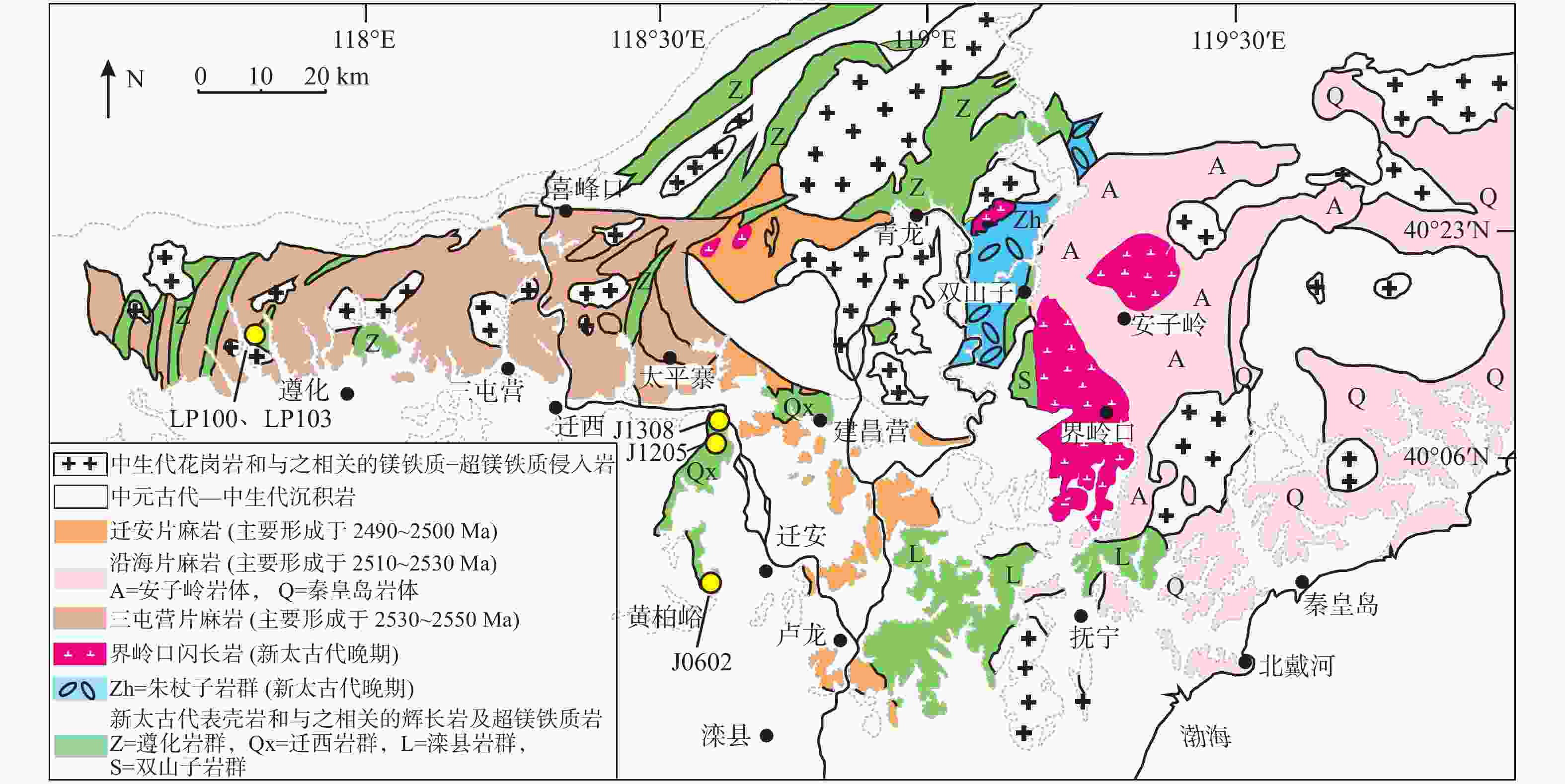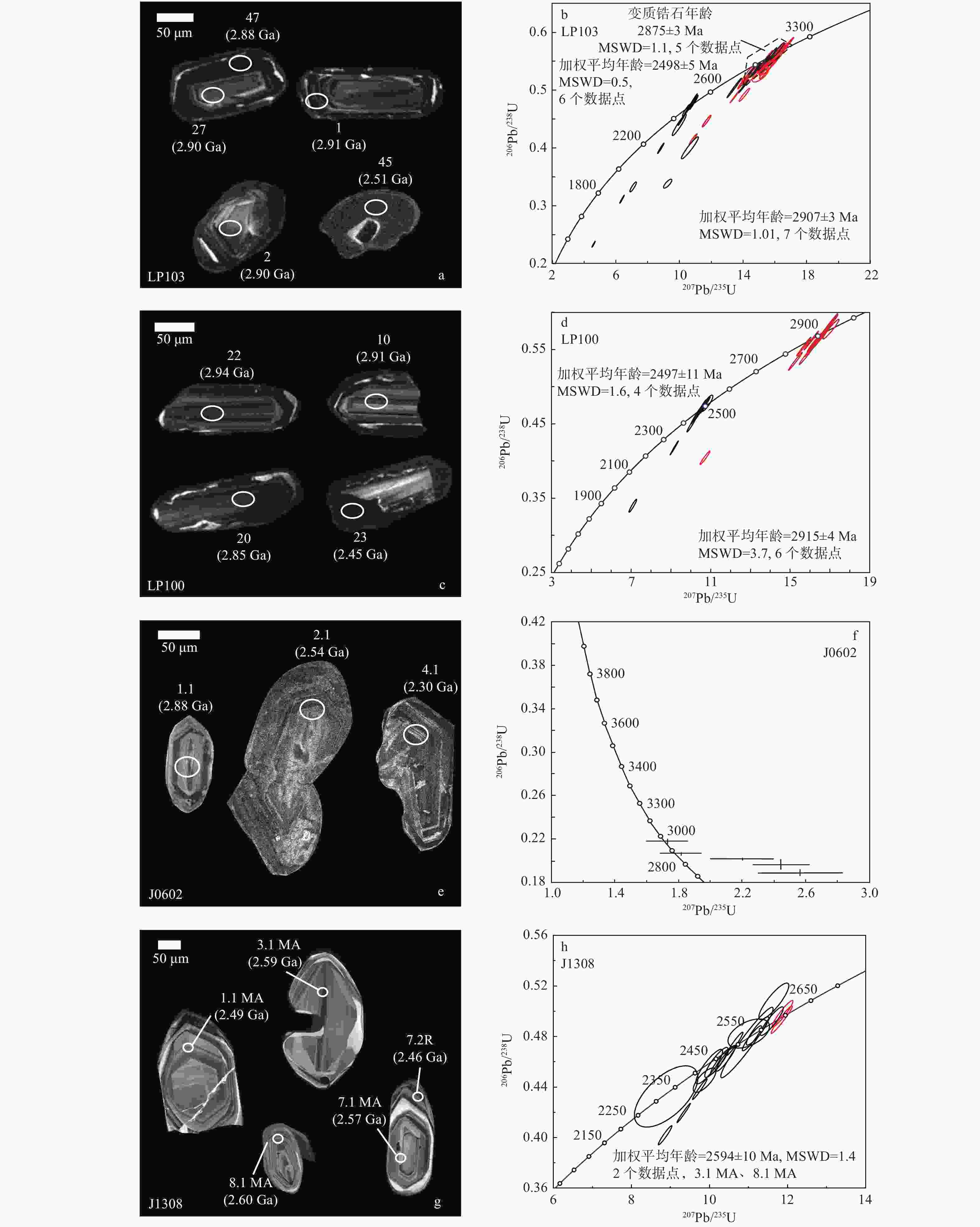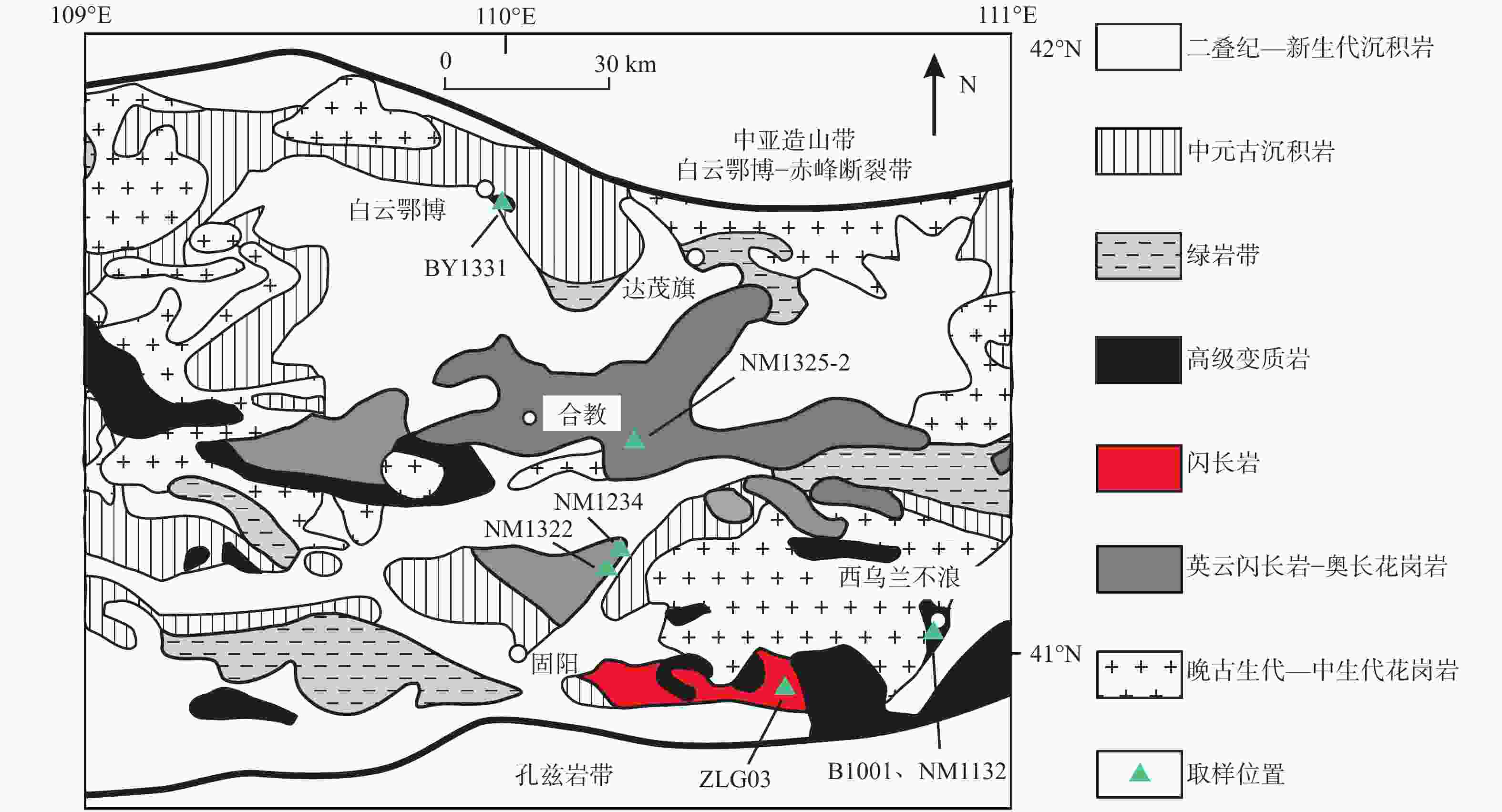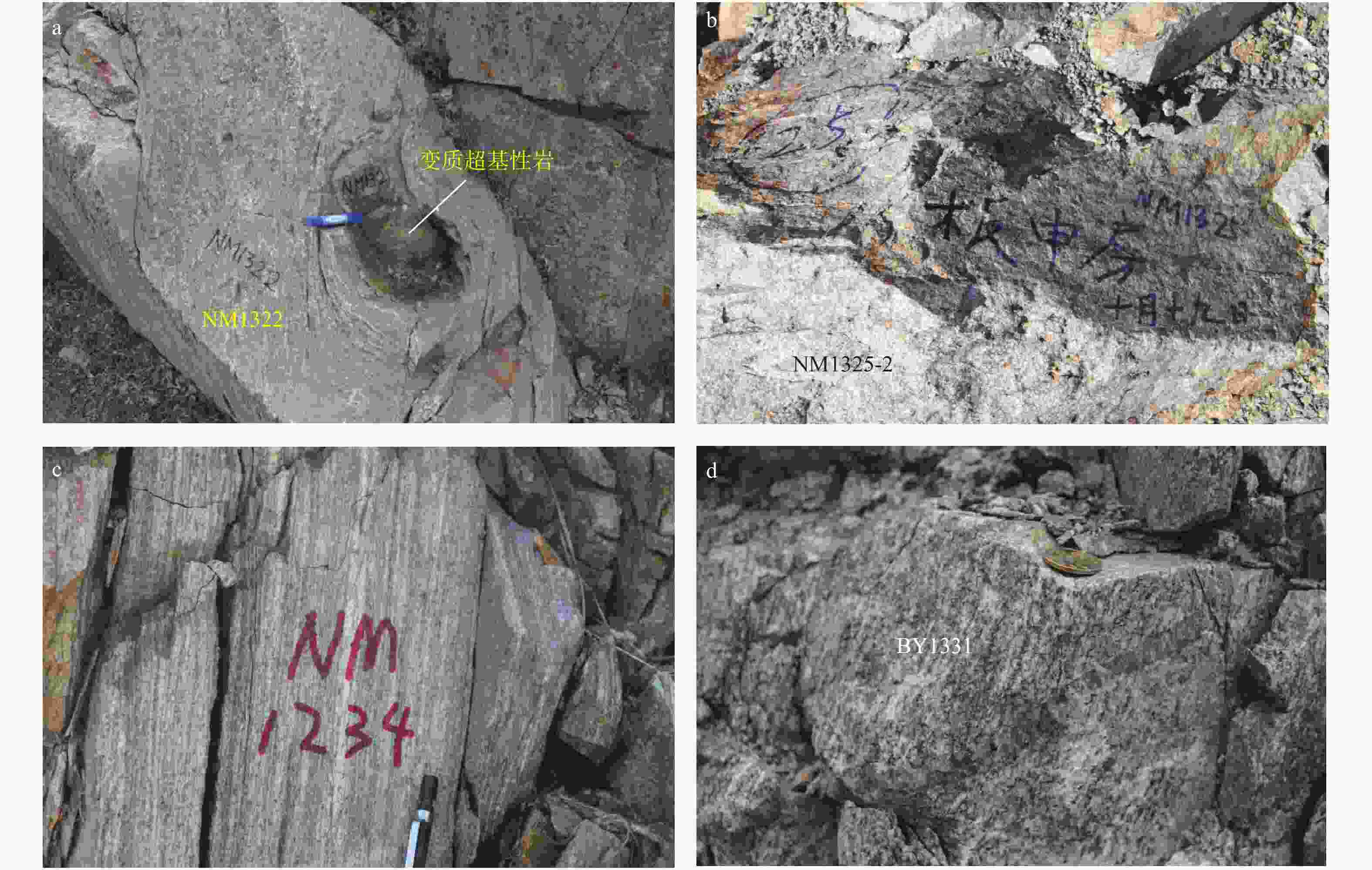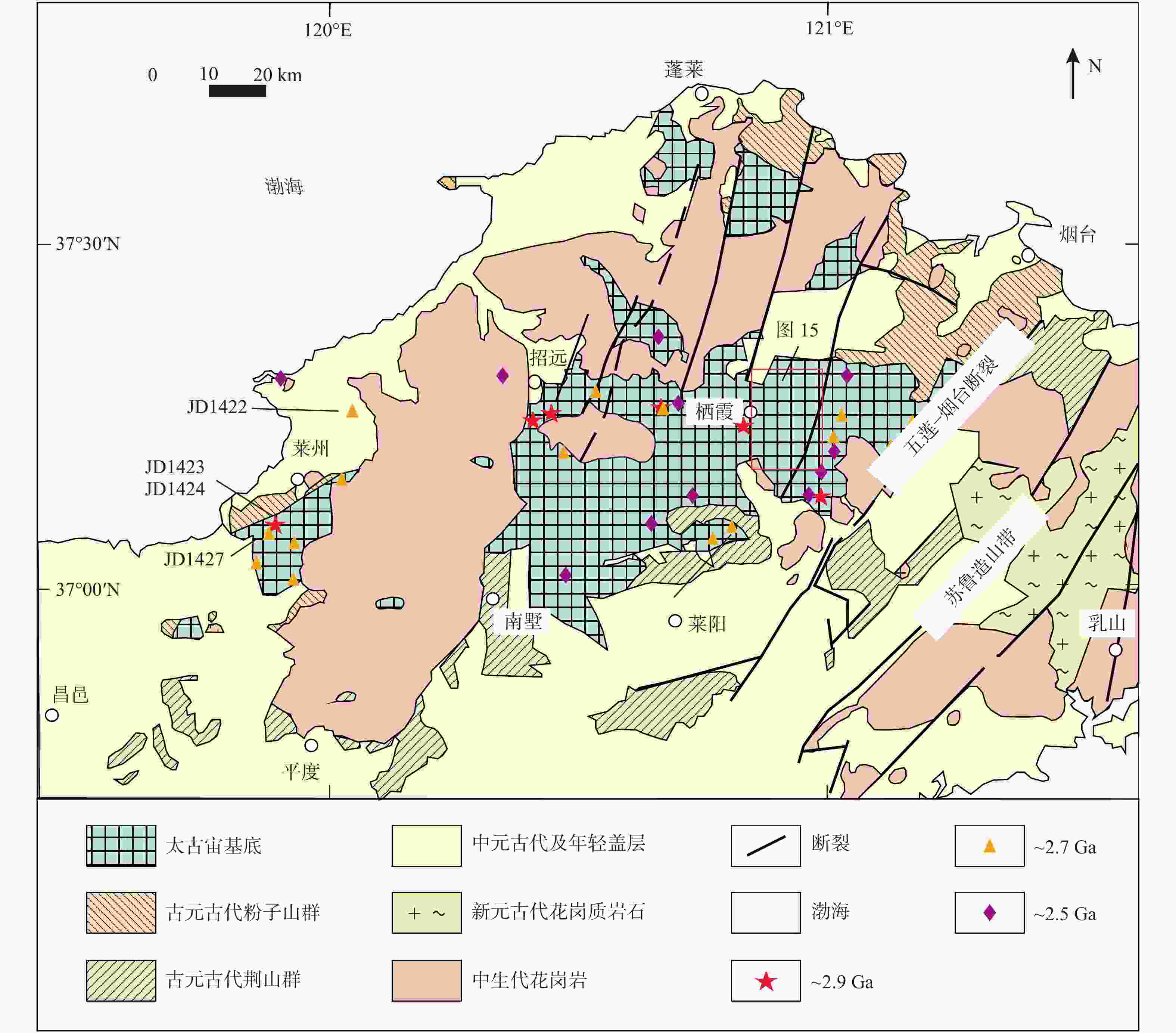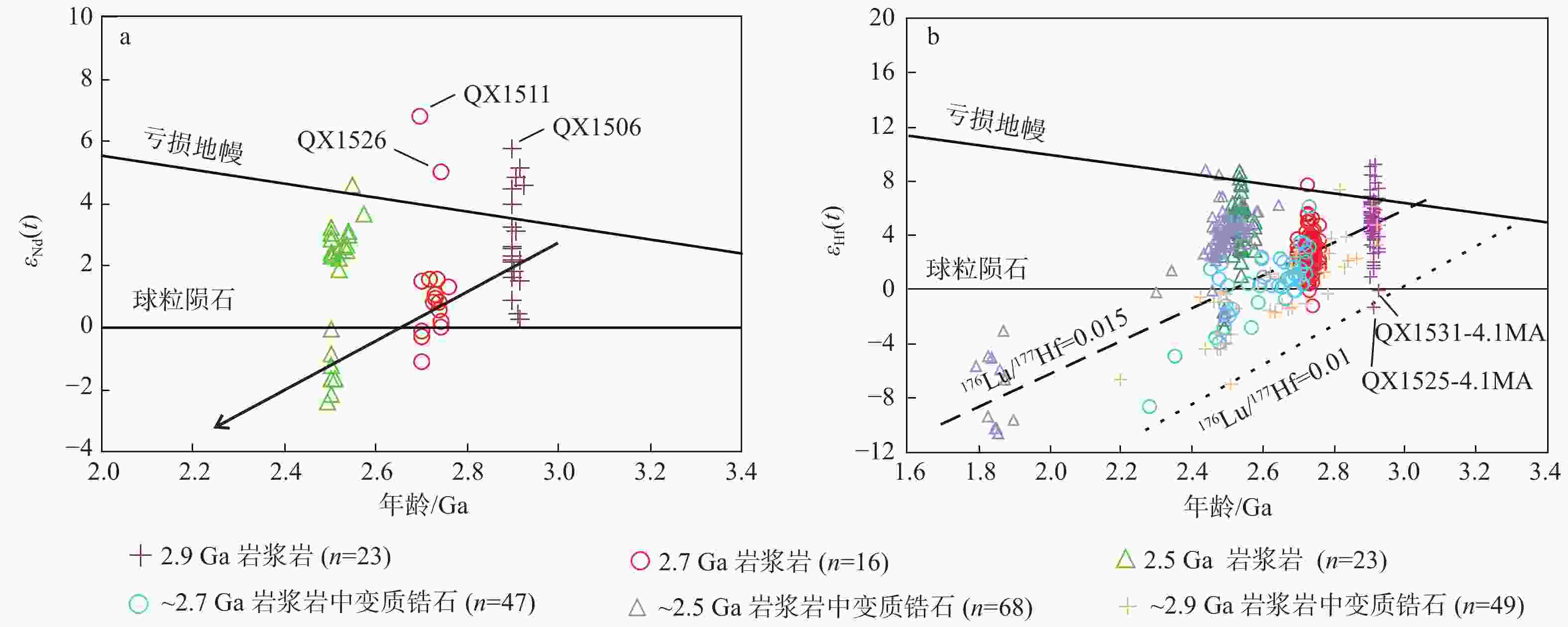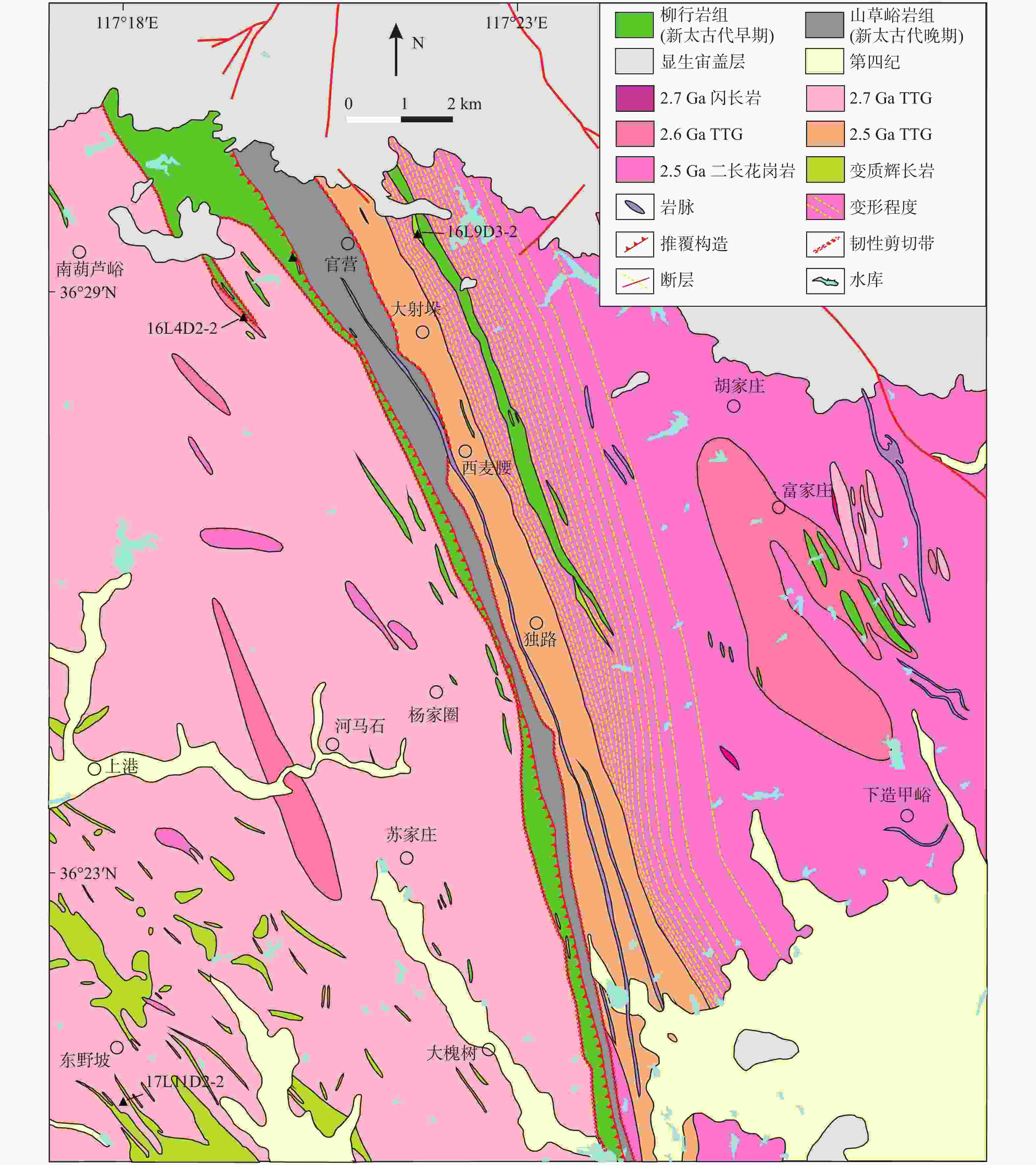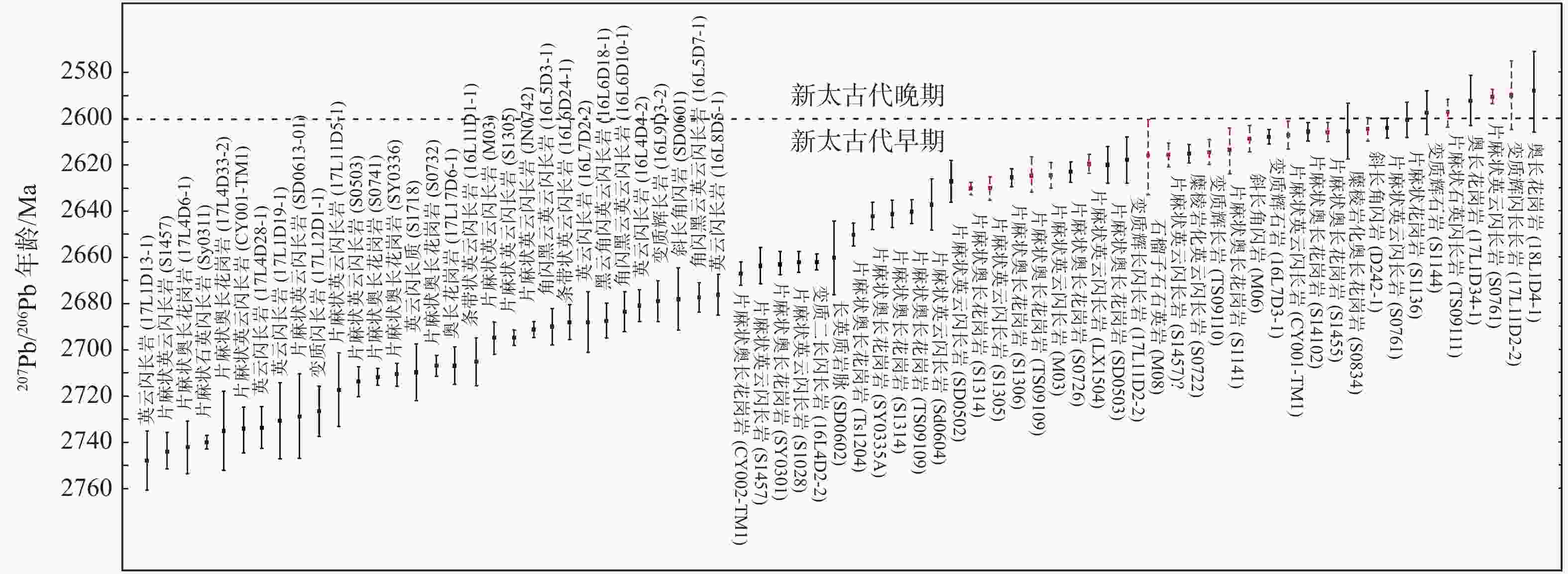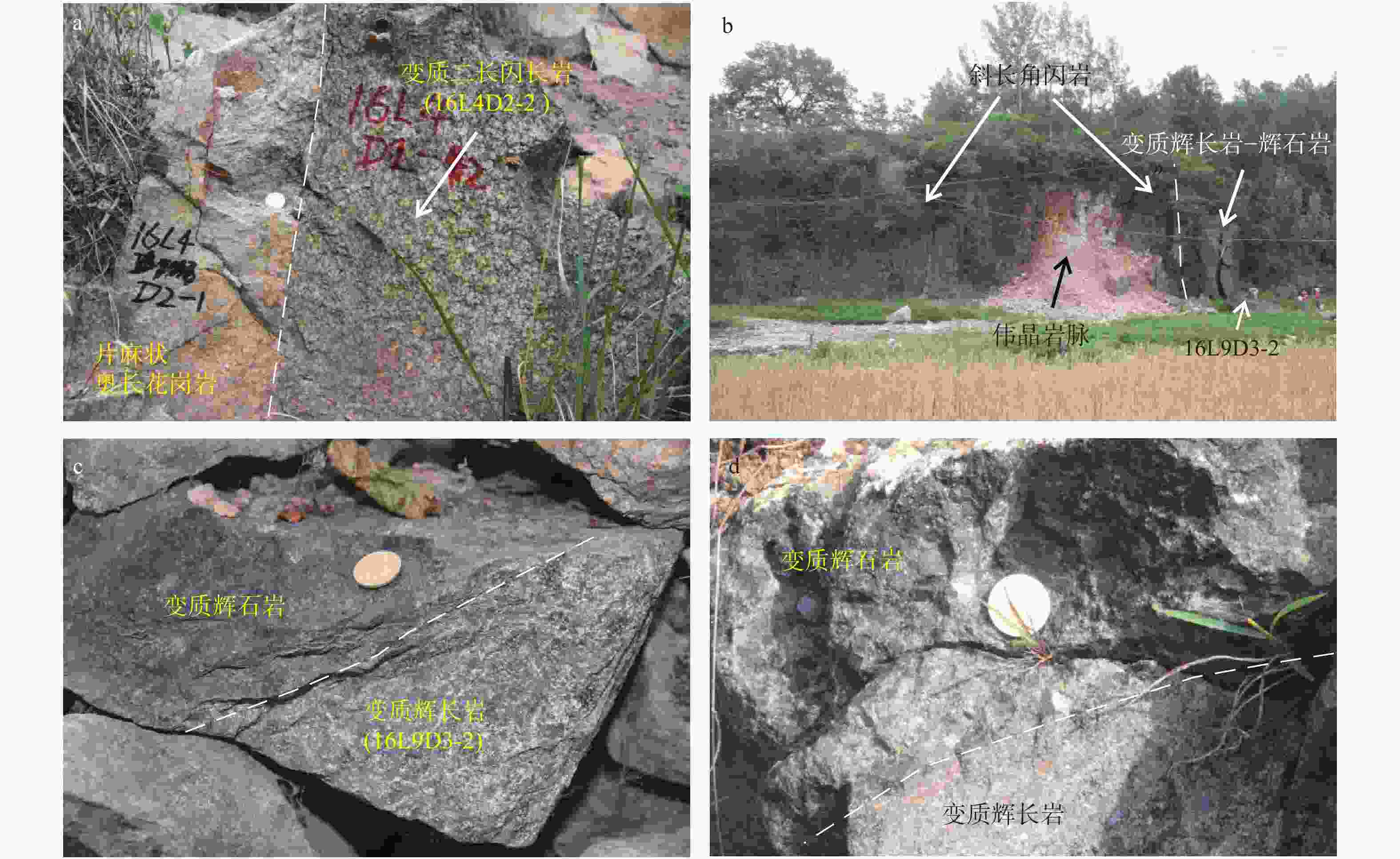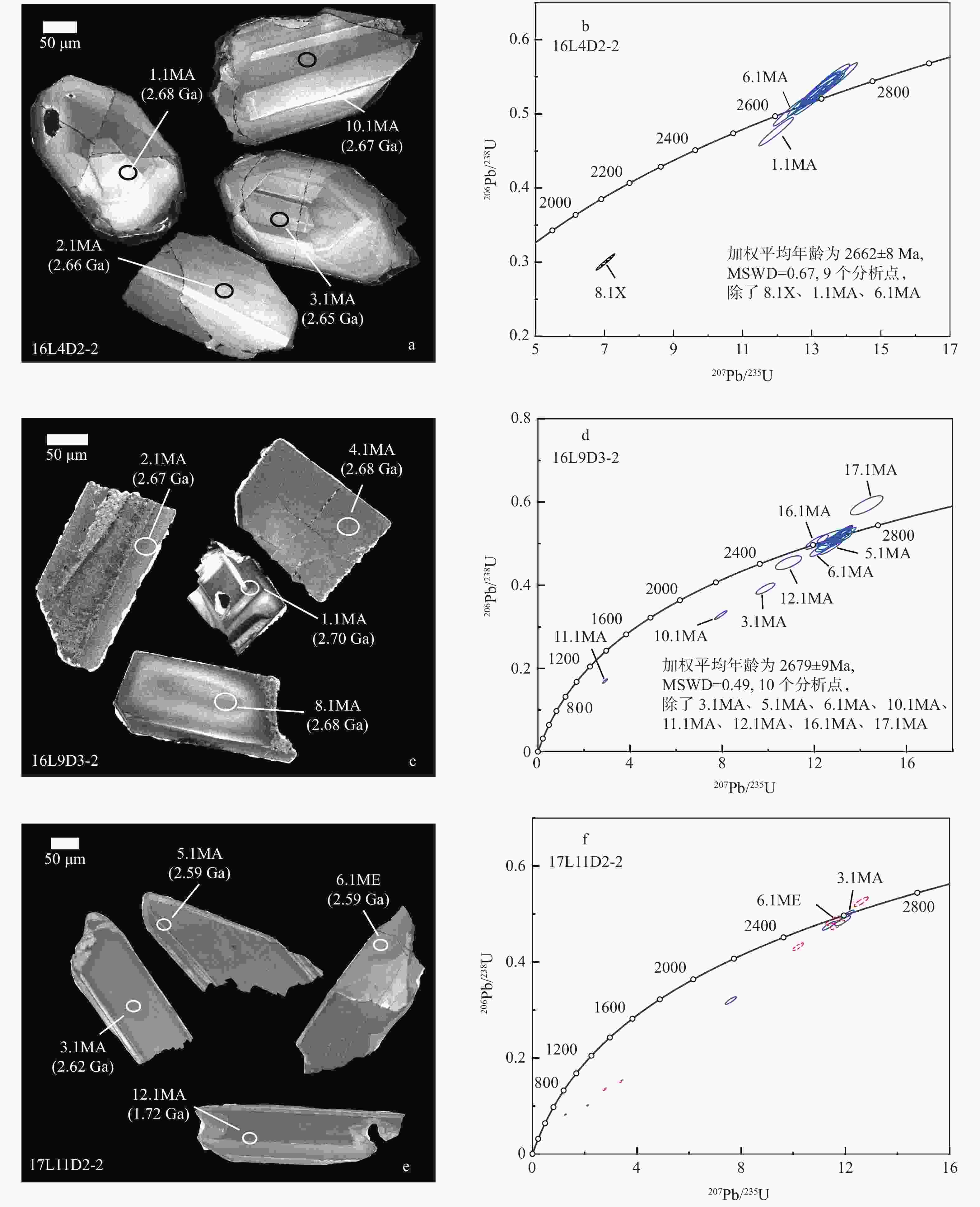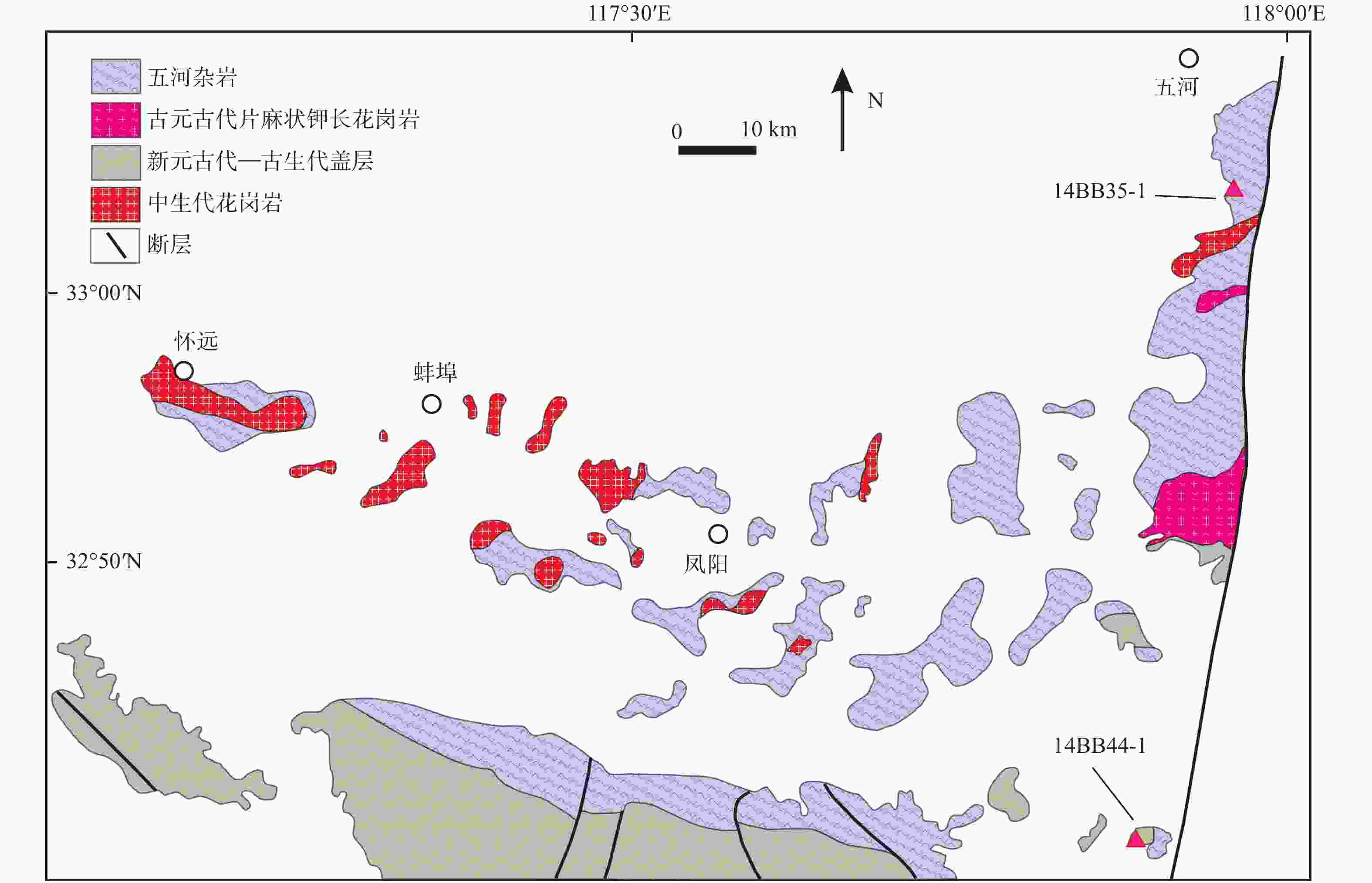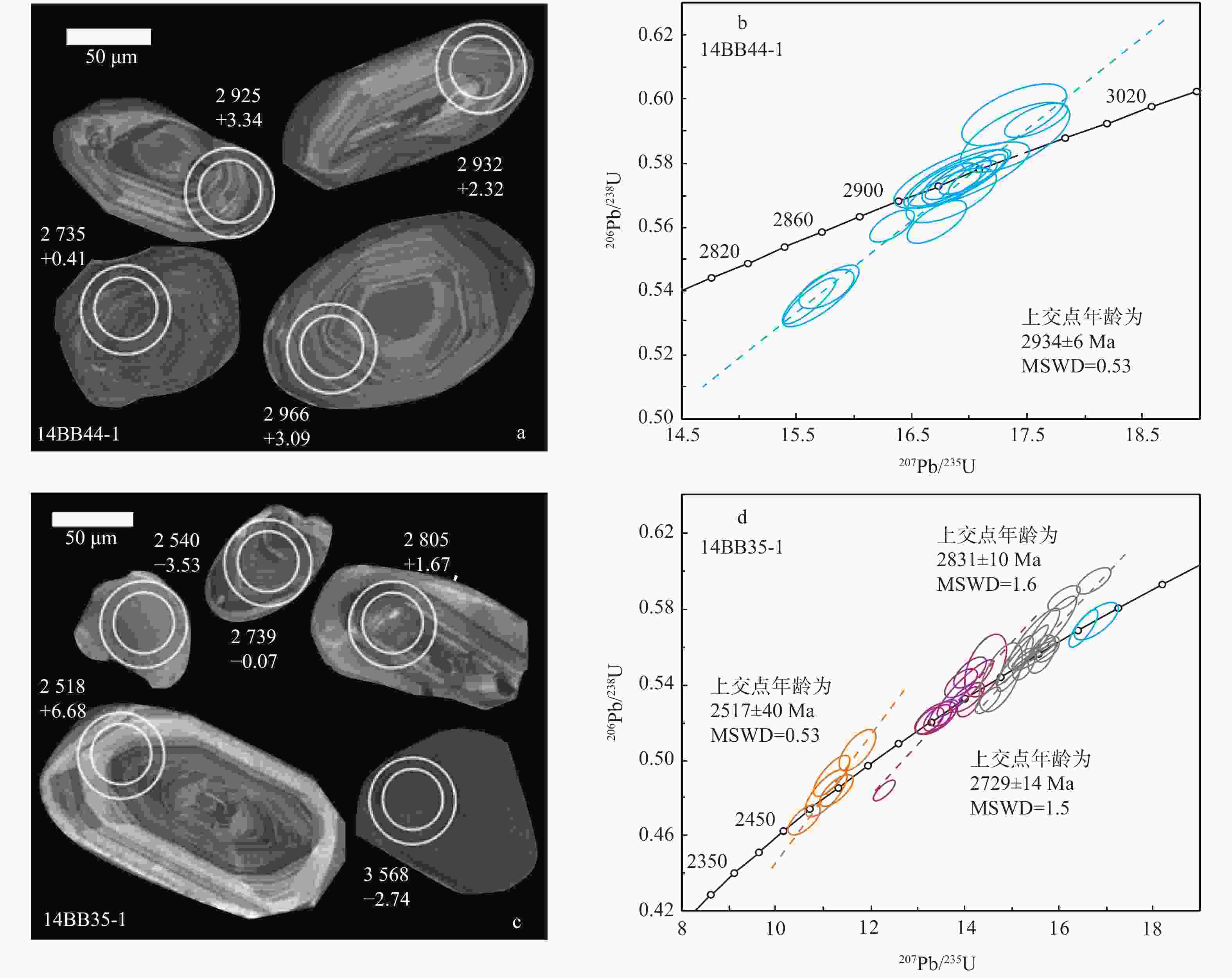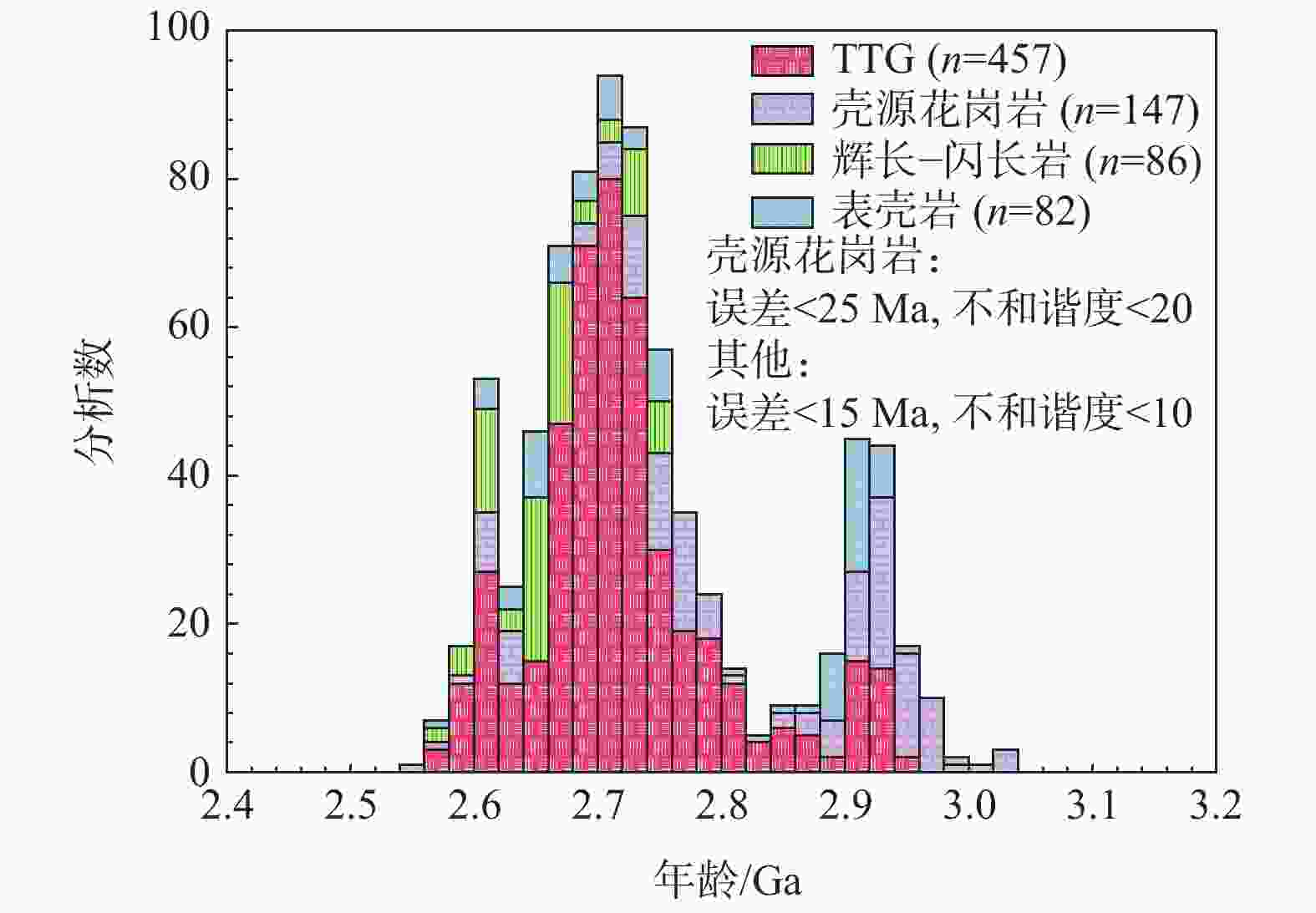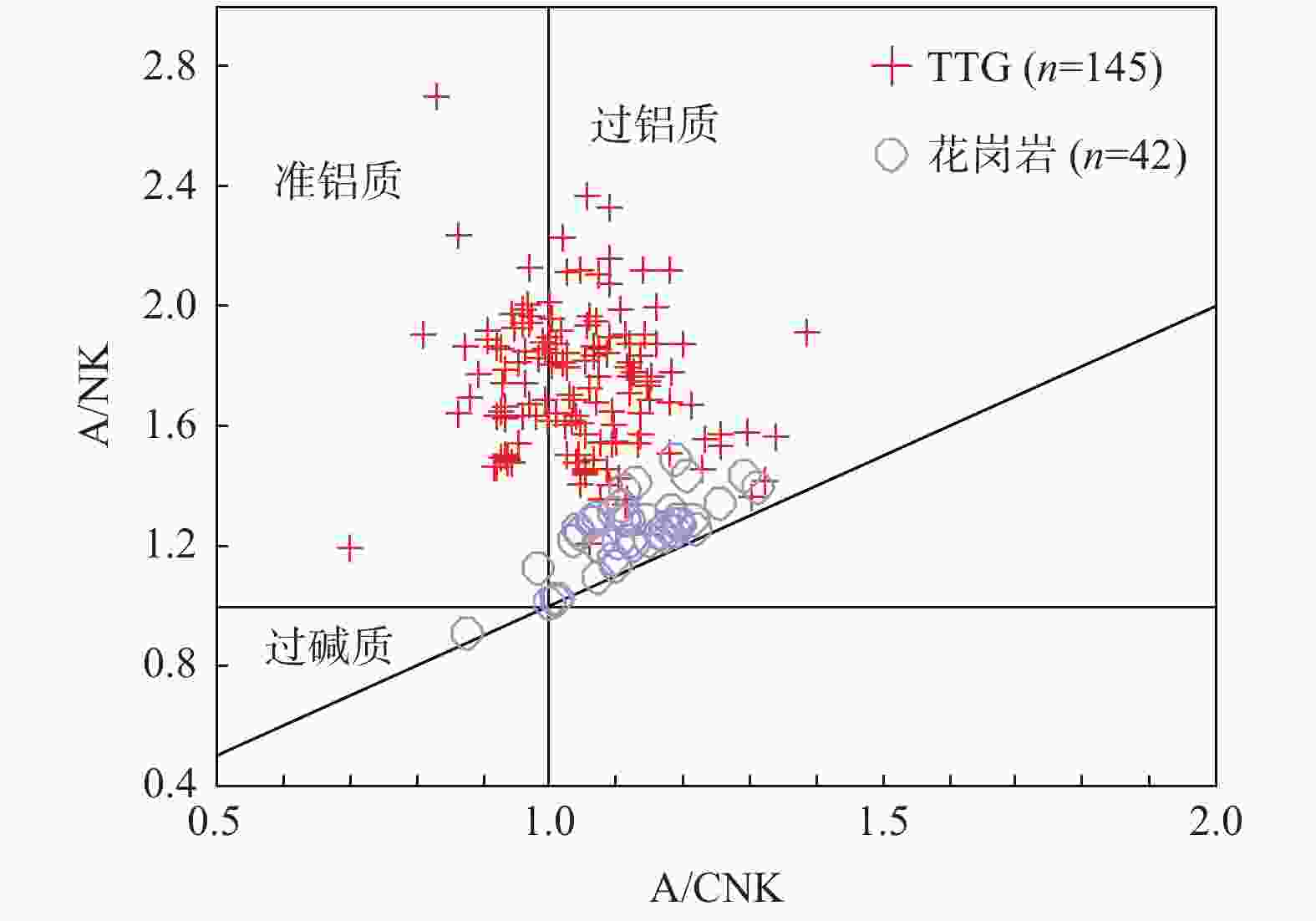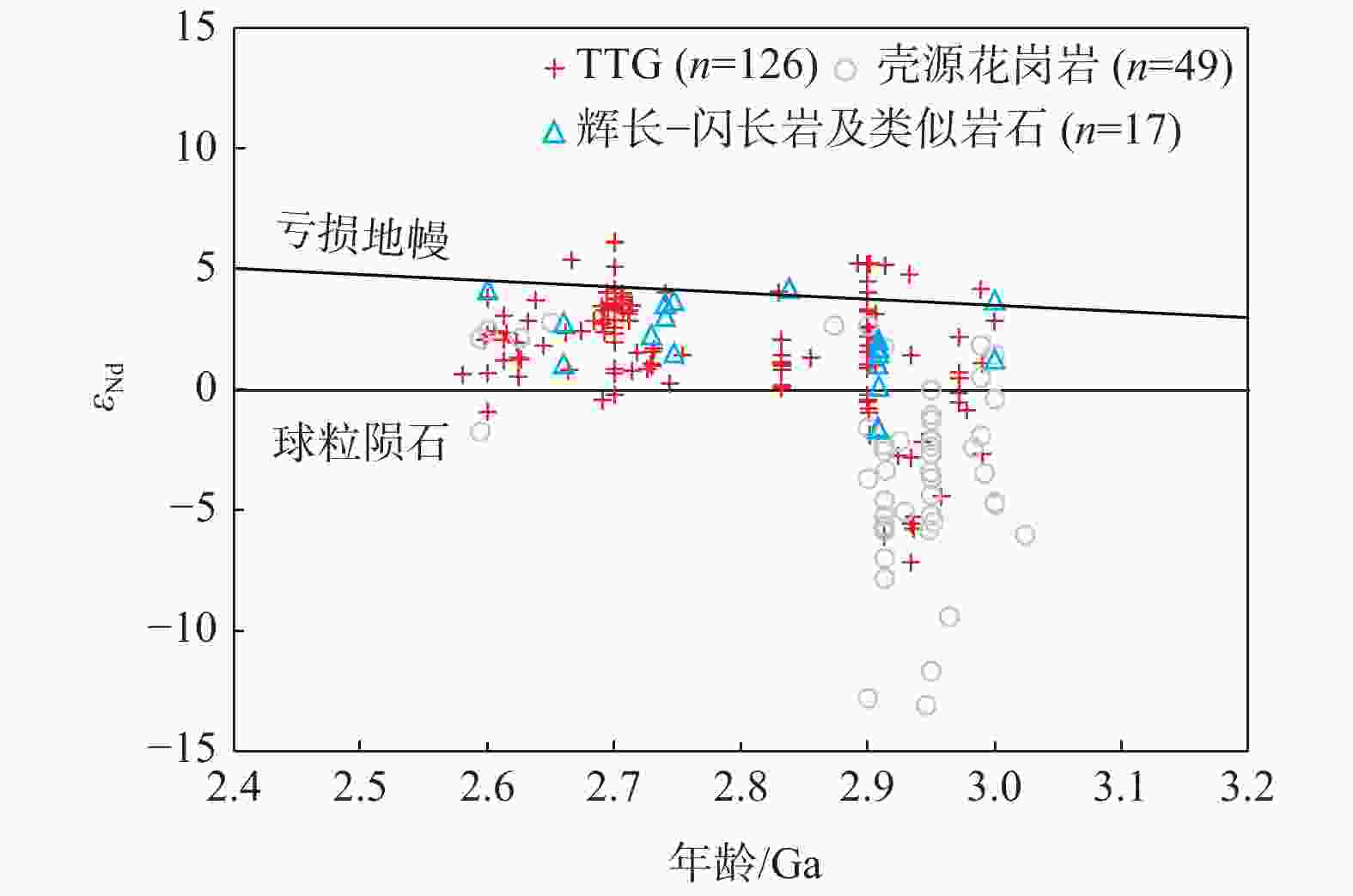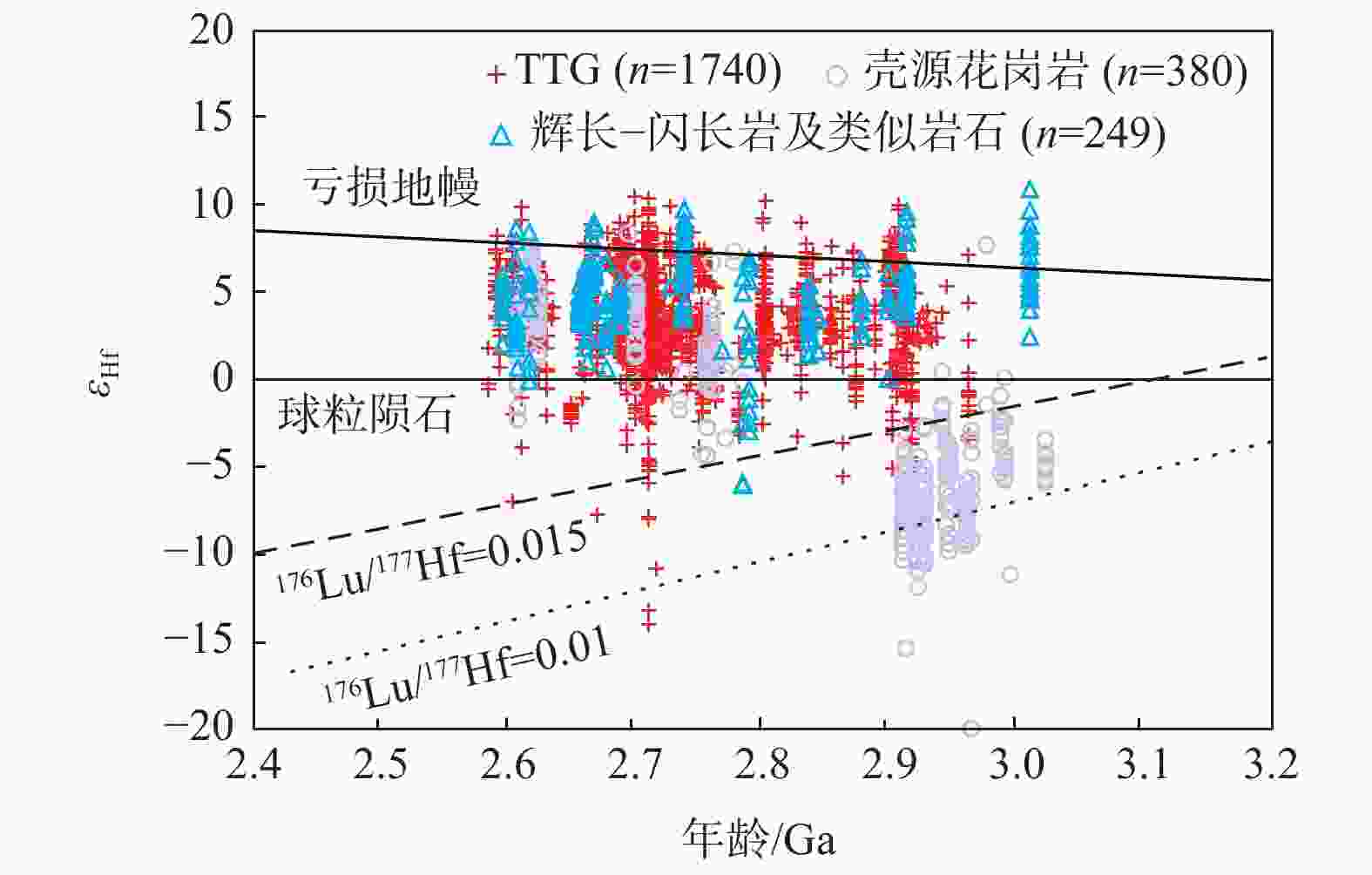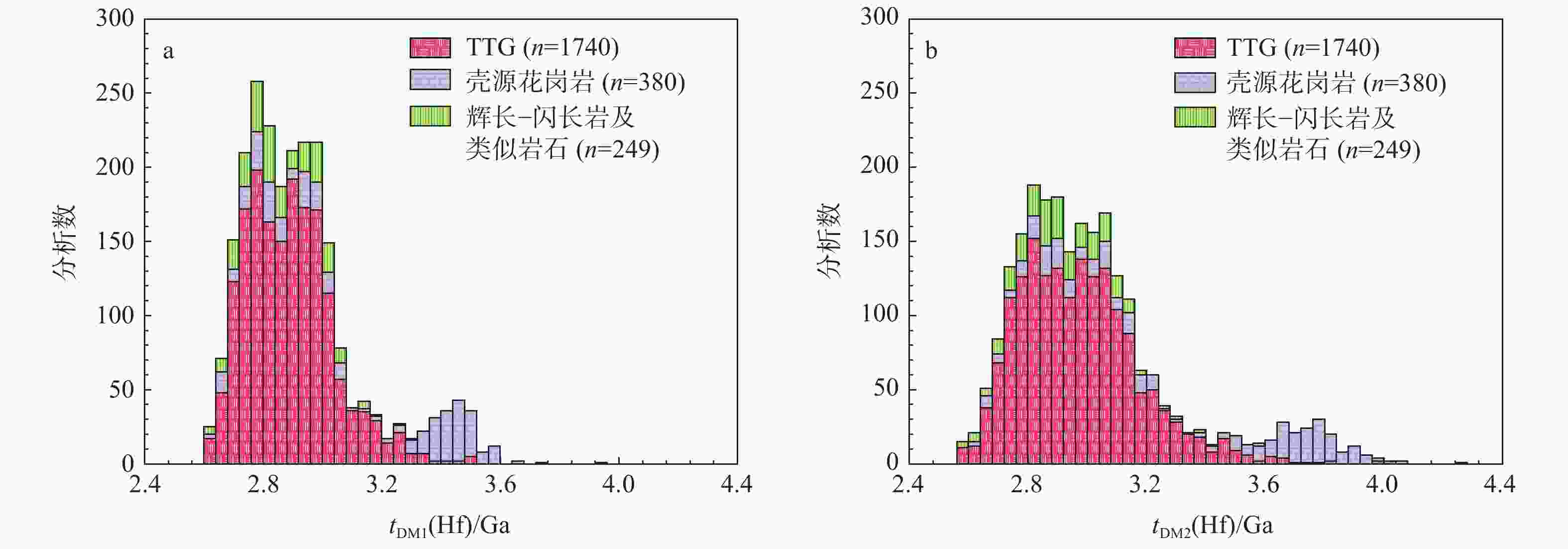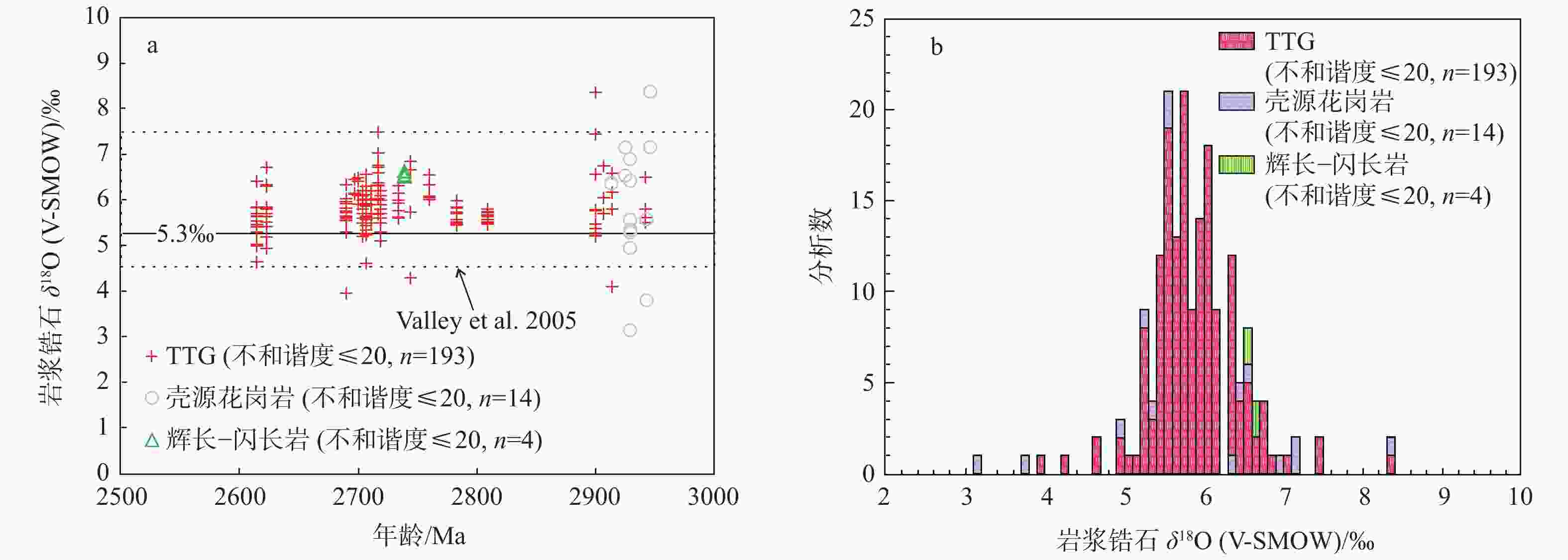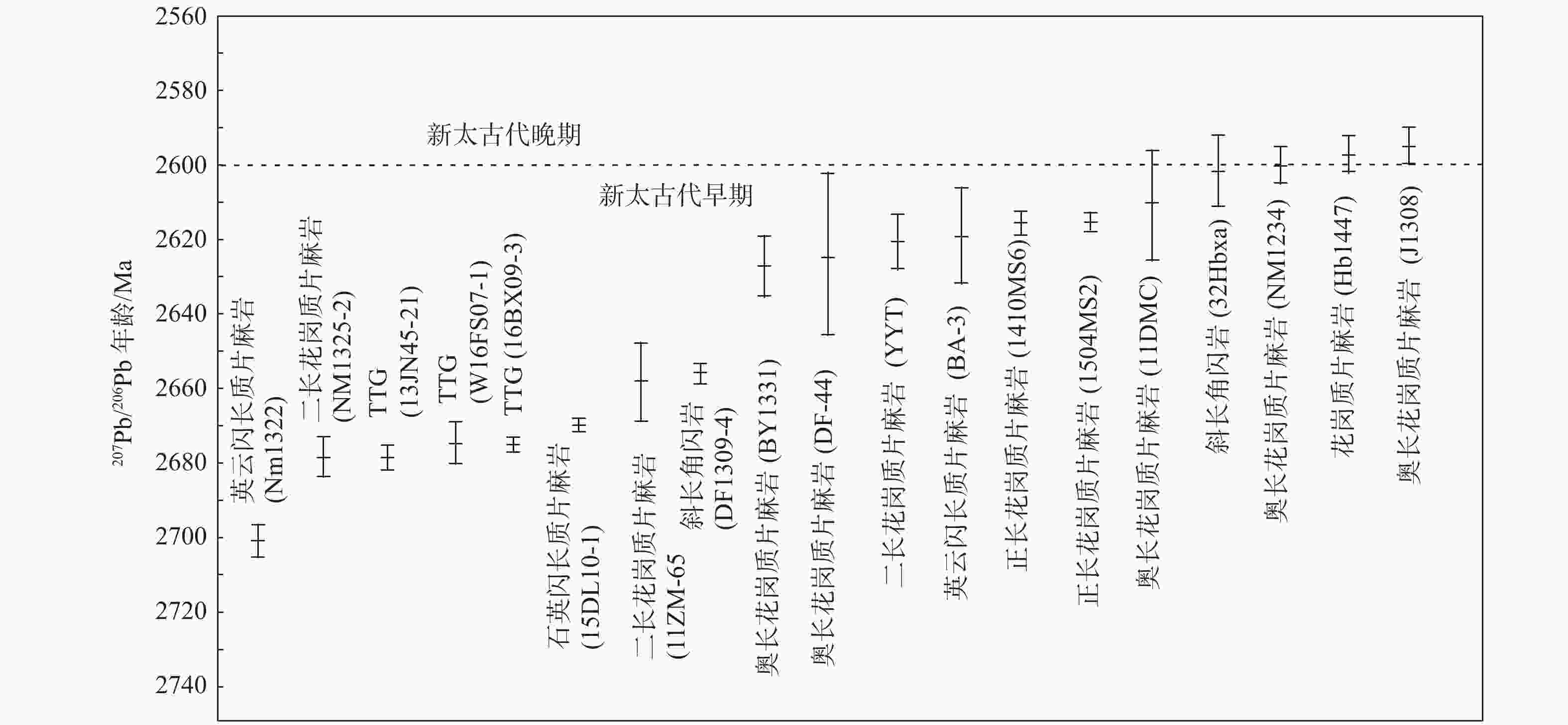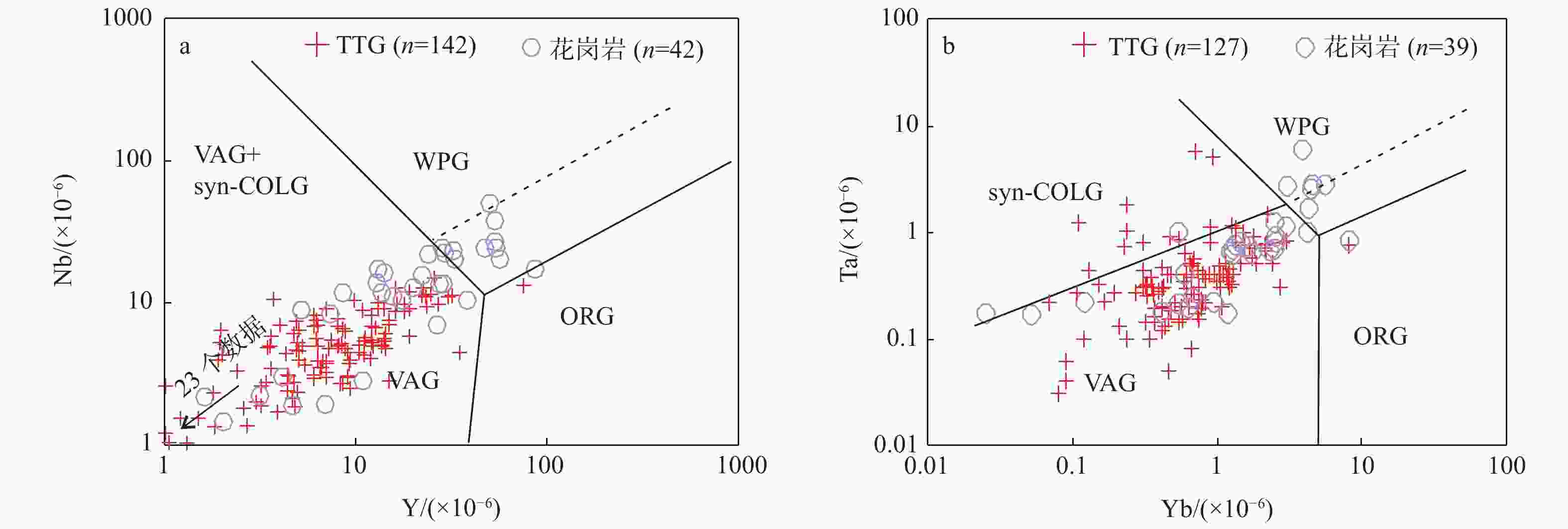Huge growth of the late Mesoarchean–early Neoarchean (2.6~3.0 Ga) continental crust in the North China Craton: A review
-
摘要: 在对一些重点地区新太古代早期—中太古代晚期(2.6~3.0 Ga)岩石的空间分布、岩石类型和形成时代作简要介绍基础上,文章总结了华北克拉通这一时代花岗质岩石的年龄分布模式、地球化学和Nd-Hf-O同位素组成特征。新太古代早期—中太古代晚期变质基底具有如下特征:①新太古代早期—中太古代晚期岩浆作用在华北克拉通几乎连续分布,峰期为2.70~2.75 Ga;②新太古代早期—中太古代晚期岩石在华北克拉通广泛存在,主要分布在东部古陆块、中部古陆块和南部古陆块中;③新太古代早期—中太古代晚期侵入岩以英云闪长岩为主,存在奥长花岗岩和花岗闪长岩及其他类型岩石;④新太古代早期—中太古代晚期表壳岩规模很小,零星分布于花岗质岩石中,岩石类型主要为变玄武质岩石,一些地区存在变质科马提岩、变质安山质‒英安质火山岩和变质碎屑沉积岩;⑤2.6 Ga可作为华北克拉通新太古代早期和晚期的界线;⑥TTG岩石的Sr/Y和La/Yb比值存在很大变化,在Sr/Y-Y和La/Yb-Yb图中位于高压、中压和低压TTG分布区;除少量富钾花岗岩外,华北克拉通新太古代早期—中太古代晚期岩石大都具有亏损Nd-Hf同位素组成特征;岩浆锆石O同位素组成与全球太古宙岩浆锆石类似;⑦许多地区都具有类似地质特征,但一些地区显示出较大的独特性。新的研究进一步支持了这样的认识:与全球其他许多典型克拉通类似,新太古代早期—中太古代晚期是华北克拉通最重要的陆壳增生时期,主要区别是华北克拉通叠加了强烈的新太古代晚期岩浆构造热事件。
-
关键词:
- 新太古代早期—中太古代晚期 /
- 华北克拉通 /
- Nd-Hf-O同位素 /
- TTG /
- 陆壳巨量增生
Abstract: Based on a brief introduction of the spatial distribution, rock types and formation ages of the late Mesoarchean–early Neoarchean (2.6~3.0 Ga) rocks in some key areas of the North China Craton, this paper summarizes the ages and geochemical and Nd-Hf-O isotopic compositions of the granitoids all over the craton. The late Mesoarchean–early Neoarchean basement shows the following features: (1) The late Mesoarchean–early Neoarchean magmatism is almost continuous, with a peak period of 2.70~2.75 Ga; (2) The late Mesoarchean–early Neoarchean rocks widely occur in the North China Craton, mainly in the Eastern Ancient Terrane, the Central Ancient Terrane and the Southern Ancient Terrane; (3) The intrusive rocks are mainly tonalite in composition, with trondhjemite, granodiorite, K-rich granite and gabbro-diorite; (4) The supracrustal rocks are commonly small in scale and scatter in granitoids. The rock types are mainly meta-basaltic rocks. In some areas, there are meta-komatiites, meta-andesitic-dacitic rocks and meta-clastic sedimentary rocks; (5) 2.6 Ga can be regarded as the boundary between the early and late Neoarchean in the North China Craton; (6) TTG rocks show large Sr/Y and La/Yb variations, plotting in the high-, medium- and low-pressure TTG areas in the Sr/Y–Y and La/Yb–Yb diagrams. Except for a few K-rich granites, the late Mesoarchean–early Neoarchean rocks are commonly depleted in Nd-Hf isotope compositions, with the magmatic zircon being similar in O isotope composition to that of the Archean magmatic zircon worldwide; (7) Many regions have similar geological characteristics, but some regions show great uniqueness. The research futher supports the understanding that, similar to many other typical cratons worldwide, the late Mesoarchean–early Neoarchean is the most important period of continental accretion in the North China Craton, and the main difference is that the North China Craton underwent a strong and widespread magmato-tectonothermal event at the end of the Neoarchean. -
图 1 华北克拉通早前寒武纪基底地质图(图中给出了2.6 ~ 3.0 Ga岩石空间分布和图2、图4、图7、图11、图14、图19、图23和图25的位置)
BB—蚌埠;CD—承德;DQS—大青山;DF—登封;EH—冀东;ES—胶东;FP—阜平;HA—怀安;HB—鹤壁;HS—恒山;HL—和龙;HQ—霍邱;LL—吕梁;LS—鲁山;MY—密云;NL—辽北;SJ—吉南;SL—辽南;WL—辽西;WS— 鲁西;WT—五台;XQL—小秦岭;YS—阴山;ZH—赞皇;ZJK—张家口;ZT—中条
Figure 1. Geological map of the early Precambrian basement of the North China Craton(showing spatial distribution of 2.6~3.0 Ga rocks and locations of figures 2, 4, 7, 11, 14, 19, 23 and 25)
BB–Bengbu; CD–Chengde; DQS–Daqingshan; DF–Dengfeng; EH–eastern Hebei; ES–eastern Shandong; FP–Fuping; HA–Huai’an; HB–Hebi; HS–Hengshan; HL–Helong; HQ–Huoqiu; LL–Lvliang; LS–Lushan; MY–Miyun; NL–northern Liaoning; SJ–southern Jilin; SL–southern Liaoning; WL–weastern Liaoning; WS–western Shandong; WT–Wutai; XQL–Xiaoqinling; YS–Yinshan; ZH–Zanhuang; ZJK–Zhangjiakou; ZT–Zhongtiao
图 2 吉南‒辽北地区地质图(图中给出了2.6~3.0 Ga岩石定年样品分布,据Bao et al.,2022修改)
Figure 2. Geological map of the southern Jilin–northern Liaoning area, showing the spatial distribution of 2.6 ~ 3.0 Ga dated rock samples (modified from Bao et al., 2022)
图 3 吉南‒辽北地区新太古代早期岩石的锆石CL图像和U-Pb谐和图
a、b—2.73 Ga英云闪长质片麻岩,歪头山(16BX03-3;Bao et al., 2022);c、d—2.68 Ga TTG,白山西北(13JN45-2;Bao et al., 2022);e、f—2.69 Ga英云闪长质片麻岩,清原东(14SJ02-1;Wu et al., 2021);g、h—2.78 Ga奥长花岗质片麻岩,夹皮沟西北(14SJ06-1;Wu et al., 2021)
Figure 3. CL images and SHRIMP U-Pb concordia diagrams for zircons from the early Neoarchean rocks in the southern Jilin–northern Liaoning area
(a) and (b) 2.73 Ga tonalitic gneiss , Waitoushan, (16BX03-3; Bao et al., 2022); (c) and (d) 2.68 Ga TTG, northwest of Baishan (13JN45-2; Bao et al., 2022); (e) and (f) 2.69 Ga tonalitic gneiss, east of Qingyuan (14SJ02-1; Wu et al., 2021); (g) and (h) 2.78 Ga trondhjemitic gneiss (14SJ06-1; Wu et al., 2021)
图 4 铁架山‒弓长岭地区地质图(底图据Dong et al., 2017a;图中给出了2.9~3.0 Ga富钾花岗岩定年样品位置,数据来源Dong et al., 2017a;王伟等, 2022)
Figure 4. Geological map of the Tiejiashan–Gongchangling area (Dong et al., 2017a), showing the locations of dated 2.9~3.0 Ga K-rich granite samples (Dong et al., 2017a; Wang et al., 2022)
图 5 铁架山‒弓长岭地区中太古代花岗质岩石的野外照片
a—2.95 Ga正长花岗质片麻岩(A0502,铁架山‒弓长岭富钾花岗岩),铁架山北(Dong et al., 2017a);b—2.92 Ga糜棱岩化细粒正长花岗岩(A1211,铁架山‒弓长岭富钾花岗岩),小岭子西(Dong et al., 2017a);c—2.92 Ga糜棱岩化细粒正长花岗岩(A1211)与2.91 Ga糜棱岩化细粒正长花岗岩(A1212)界线,与图5b位置相同(Dong et al., 2017a);d—2.99 Ga 二长花岗质片麻岩(A0533,东鞍山花岗岩),东鞍山东野外照片中,笔的长度为14 cm,硬币的直径为2 cm;下同
Figure 5. Field photographs of the Mesoarchean granitoids in the Tiejiashan–Gongchangling area
(a) 2.95 Ga syenogranitic gneiss (A0502, Tiejiashan–Gongchangling K-riched granite), north of Tiejiashan (Dong et al., 2017a); (b) 2.92 Ga mylonitized fine-grained syenogranite (A1211, Tiejiashan–Gongchangling K-riched granite), west of Xiaolingzi (Dong et al., 2017a); (c) Boundary between the 2.92 Ga mylonitized fine-grained syenogranite (A1211) and the 2.91 Ga mylonitized fine-grained syenogranite (A1212), same location as Fig.5b (Dong et al., 2017a); (d) 2.99 Ga monzogranitic gneiss (A0533), east of Donganshan Samples A0502 and A1211 are from the Tiejiashan–Gongchangling K-rich granite, and sample A0533 is from the Donganshan granite. The pen is 14 cm in length, whereas the coin is 2 cm in diameter, the same below.
图 6 铁架山‒弓长岭地区中太古代花岗质岩石的锆石阴极发光图像和U-Pb谐和图
a、b—2.95 Ga正长花岗质片麻岩,铁架山北(A0502;Dong et al., 2017a);c、d—2.92 Ga糜棱岩化细粒正长花岗岩,小岭子西(A1211;Dong et al., 2017a);e、f—2.99 Ga 二长花岗质片麻岩,东鞍山东(A0533)
Figure 6. CL images and SHRIMP U-Pb concordia diagrams for zircons from the Mesoarchean granitoids in the Tiejiashan–Gongchangling area
(a) and (b) 2.95 Ga syenogranitic gneiss, north of Tiejiashan (A0502; Dong et al., 2017a); (c) and (d) 2.92 Ga mylonitized fine-grained syenogranite, west of Xiaolingzi (A1211; Dong et al., 2017a); (e) and (f) 2.99 Ga monzogranitic gneiss, east of Donganshan (A0533)
图 7 冀东地区地质图(底图据Nutman et al., 2011;图中给出了2.6~3.0 Ga 定年岩石样品的位置,数据来源Nutman et al., 2011;Liou et al., 2019)
Figure 7. Geological map of eastern Hebei (Nutman et al., 2011), showing the locations of dated 2.6~3.0 Ga rock samples (Nutman et al., 2011; Liou et al., 2019)
图 8 冀东草场地区中太古代表壳岩的野外照片(Liou et al., 2019)
a—表壳岩剖面;b、c—铁镁质片麻岩与长英质片麻岩互层,图8b中粗粒浅色体岩脉与铁镁质片麻岩平行化;d、e—浅色长英质片麻岩
Figure 8. Field photographs of the Mesoarchean supracrustal rocks in the Caochang region, eastern Hebei (Liou et al., 2019)
(a) Supracrustal rock section; (b) and (c) Mafic gneisses interbedded with felsic gneisses; a coarse-grained leucosome dyke parallels to the mafic gneisses in Fig.8b; (d) and (e) Leucocratic felsic gneisses
图 9 冀东地区新太古代早期—中太古代晚期岩石的锆石阴极发光图像和U-Pb谐和图
a、b—2.91 Ga长英质片麻岩,草场(LP103;Liou et al., 2019);c、d—2.92 Ga长英质片麻岩,与样品LP103同一位置(LP100;Liou et al., 2019);e、f—2.94 Ga英云闪长质片麻岩,曹庄(J0602; Nutman et al., 2011);g、h—2.59 Ga奥长花岗质片麻岩,刘皮庄(J1308)
Figure 9. CL images and SHRIMP U-Pb concordia diagrams for the zircons from the late Mesoarchean– early Neoarchean rocks in eastern Hebei
(a) and (b) 2.91 Ga felsic gneiss, Caochang (LP103; Liou et al., 2019); (c) and (d) 2.92 Ga felsic gneiss (LP100; Liou et al., 2019), same location as the sample LP103; (e) and (f) 2.94 Ga tonalitic gneiss, Caozhuang (J0602; Nutman et al., 2011); (g) and (h) 2.59 Ga trondhjemitic gneiss, Liupizhuang (J1308)
图 10 冀东地区新太古代早期—中太古代晚期岩石的野外照片
a—2.94 Ga英云闪长质片麻岩,曹庄(J0602;Nutman et al., 2011);b—2.59 Ga奥长花岗质片麻岩,刘皮庄(J1308)
Figure 10. Field photographs of the late Mesoarchean–early Neoarchean granitoids in eastern Hebei
(a) 2.94 Ga tonalitic gneiss, Caozhuang (J0602; Nutman et al., 2011); (b) 2.59 Ga trondhjemitic gneiss, Liupizhuang (J1308)
图 11 白云鄂博‒固阳地区地质图(底图据Jian et al.,2012修改;图中给出了新太古代早期定年岩石样品的位置,数据来源董晓杰等,2012;马铭株等,2013;董春艳等,2021)
Figure 11. Geological map of the Bayan Obe–Guyang area (modified after Jian et al.,2012), showing the locations of the dated early Neoachean rock samples (Dong et al.,2012; Ma et al., 2013; Dong et al., 2021)
图 12 白云鄂博‒固阳地区新太古代早期岩石的野外照片
a—2.70 Ga英云闪长质片麻岩(NM1322),包裹变质超基性岩,固阳东北;b—2.68 Ga二长花岗质片麻岩(NM1325-2),合教东;c—2.60 Ga奥长花岗质片麻岩(NM1234),固阳东北;d—2.63 Ga英云闪长质片麻岩(BY1331),白云鄂博东南(董春艳等,2021)
Figure 12. Field photographs of the early Neoarchean rocks in the Bayan Obe–Guyang area
(a) 2.70 Ga tonalitic gneiss (NM1322), containing a meta-ultra-mafic rock enclave, northeast of Guyang; (b) 2.68 Ga monzogranitic gneiss (NM1325-2), east of Hejiao; (c) 2.60 Ga trondhjemitic gneis (NM1234), northeast of Guyang; (d) 2.63 Ga tonalitic gneiss (BY1331), southeast of the Bayan–Obe area (Dong et al., 2021)
图 13 白云鄂博‒固阳地区新太古代早期岩石的锆石阴极发光图像和U-Pb谐和图
a、b—2.70 Ga英云闪长质片麻岩(NM1322),固阳东北;c、d—2.68 Ga二长花岗质片麻岩(NM1325-2),合教东;e、f—2.60 Ga奥长花岗质片麻岩(NM1234),固阳东北;g、h—2.63 Ga英云闪长质片麻岩(BY1331),白云鄂博东南(董春艳等,2021)
Figure 13. CL images and SHRIMP U-Pb concordia diagrams for the zircons from the early Neoarchean rocks in the Bayan Obe–Guyang area
(a) and (b) 2.70 Ga tonalitic gneiss (NM1322), containing a meta-ultra-mafic rock enclave, northeast of Guyang; (c) and (d) 2.68 Ga monzogranitic gneiss (NM1325-2), east of Hejiao; (e) and (f) 2.60 Ga trondhjemitic gneiss (NM1234), northeast of Guyang; (g) and (h) 2.63 Ga tonalitic gneiss (BY1331), southeast of the Bayan–Obe area (Dong et al., 2021)
图 14 胶东地区地质图(Wan et al., 2015;图中给出了太古宙岩石定年样品空间分布(栖霞地区除外)和图15的位置)
Figure 14. Geological map of eastern Shandong Province, North China Craton (Wan et al., 2015), showing the spatial distribution of the dated Archean rock samples (except the Qixia area) and the location of Fig.15
图 15 栖霞地区地质图(万渝生等,2017;Wan et al., 2021;图中给出了太古宙定年样品位置,三角、方框和圆圈分别代表2.9 Ga、2.7 Ga和2.5 Ga岩石样品)
Figure 15. Geological map of the Qixia area (Wan et al., 2017; Wan et al., 2021), showing the spatial distribution of the dated Archean rocks, with triangle, square and circle represent 2.9 Ga, 2.7 Ga and 2.5 Ga rock samples, respectively
图 16 栖霞地区太古宙岩浆岩的Nd-Hf同位素组成(Wan et al., 2021)
a—全岩εNd(t)−年龄图;b—锆石εHf(t)−年龄图
Figure 16. Nd-Hf isotopic composition of the Archean magmatic rocks in the Qixia area (Wan et al., 2021)
(a) Whole-rock εNd(t) vs. age diagram; (b) zircon εHf(t) vs. age diagram
图 17 胶东莱州地区太古宙岩石的野外照片(万渝生等,2019a)
a—2.88 Ga带状英云闪长岩(JD1423),下埠东;b—2.92 Ga 闪长质片麻岩(JD1424),与样品JD1423位置相同;c—2.73 Ga条带状英云闪长岩(JD1422),张家埠;d—2.70 Ga英云闪长质片麻岩(JD1427),包裹变质辉长岩包体,下埠南
Figure 17. Field photographs of the Archean rocks in the Laizhou area, eastern Shandong (Wan et al., 2019a)
(a) 2.88 Ga banded tonalite (JD1423), east of Xiafu; (b) 2.92 Ga dioritic gneiss (JD1424), same location as the sample JD1423; (c) 2.73 Ga banded tonalite (JD1422), Zhangjiafu; (d) 2.70 Ga tonalitic gneiss (JD1427), containing meta-gabbro enclaves, south of Xiafu
图 18 胶东莱州地区太古宙岩石的锆石阴极发光图像和U-Pb谐和图(万渝生等,2019a)
a、b—2.88 Ga带状英云闪长岩(JD1423),下埠东;c、d—2.92 Ga 闪长质片麻岩(JD1424),与样品JD1423位置相同;e、f—2.73 Ga条带状英云闪长岩(JD1422),张家埠;g、h—2.70 Ga英云闪长质片麻岩(JD1427),下埠南
Figure 18. CL images and SHRIMP U-Pb concordia diagrams for zircons from the Archean rocks in the Laizhou area, eastern Shandong (Wan et al., 2019a)
(a) and (b) 2.88 Ga banded tonalite (JD1423), east of Xiafu; (c) and (d) 2.92 Ga dioritic gneiss (JD1424), same location as the sample JD1423; (e) and (f) 2.73 Ga banded tonalite (JD1422), Zhangjiafu; (g) and (h) 2.70 Ga tonalitic gneiss (JD1427), south of Xiafu
图 19 鲁西七星台地区地质图(底图据Bai et al., 2020;图中给出了新太古代早期定年样品位置,数据来源马铭株等,2020)
Figure 19. Geological map of the Qixingtai area, western Shandong (Bai et al., 2020), showing the locations of the dated early Neoachean rock samples (Ma et al., 2020)
图 20 鲁西地区新太古代早期侵入岩的锆石年龄变化(马铭株等,2020)
黑线和红色虚线分别代表岩浆年龄和变质年龄
Figure 20. Zircon age variation for the early Neoarchean magmatic rocks in west Shandong (Ma et al., 2020)
Black line and red dotted line represent magmatic and metamorphic ages, respectively
图 21 鲁西七星台地区新太古代早期变质超基性岩—中性岩的野外照片(马铭株等,2020)
a—2.66 Ga变质闪长岩(16L4D2-2),被包裹在~2.6 Ga 奥长花岗质片麻岩中,官营西南;b—变质辉长岩‒辉石岩侵入新太古代早期柳杭岩组斜长角闪岩,界线附近又有伟晶岩脉侵入,官营东;c—2.68 Ga变质辉长岩(16L9D3-2),与变质辉石岩空间上共生,位置同图21b;d—变质辉长岩和变质辉石岩空间上共生,~2.6 Ga变质辉长闪长岩(17L11D2-2)取自该露头附近,东野坡南
Figure 21. Field photographs of the early Neoarchean meta-ultramafic to intermediate rocks in the Qixingtai area, western Shandong (Ma et al., 2020)
(a) 2.66 Ga meta-diorite (16L4D2-2), occurring as enclaves in ~2.6 Ga trondhjemitic gneiss, southwest of Guanying; (b) Meta-gabbro–pyroxenite, intruding the amphibolite of the early Neoarchean Liuhang Group, and cut by pegmatite dyke near the boundary, east of Guanying; (c) 2.68 Ga meta-gabbro (16L9D3-2), contacting with meta-pyroxenite, same location as Fig 21b; (d) Meta-gabbro, contacting with meta-pyroxenite, ~2.6 Ga meta-gabbro sample 17L11D2-2 is taken near the outcrop, south of Dongyepo
图 22 鲁西七星台地区新太古代早期变质超基性岩—中性岩的锆石阴极发光图像和U-Pb谐和图(马铭株等,2020)
a、b—2.66 Ga变质闪长岩(16L4D2-2),官营西南;c、d—2.68 Ga变质辉长岩(16L9D3-2),官营东;e、f—~2.6 Ga变质辉长闪长岩(17L11D2-2),东野坡南
Figure 22. CL images and SHRIMP U-Pb concordia diagrams for the zircons from the early Neoarchean meta-ultramafic to intermediate rocks in the Qixingtai area, western Shandong (Ma et al., 2020)
(a) and (b) 2.66 Ga meta-diorite (16L4D2-2), southwest of Guanying; (c) and (d) 2.68 Ga meta-gabbro (16L9D3-2), east of Guanying; (e) and (f) ~2.6 Ga meta-gabbro (17L11D2-2), south of Dongyepo
图 23 蚌埠地区地质图(底图据刘贻灿等,2015;图中给出了中太古代晚期定年样品位置,数据来源Liu et al., 2019)
Figure 23. Geological map of the Bengbu area (Liu et al., 2015) , showing the locations of the dated late Mesoarchean rock samples (Liu et al., 2019)
图 24 蚌埠地区中太古代晚期花岗质岩石的锆石阴极发光图像和U-Pb谐和图(Liu et al., 2019)
a、b—2.93 Ga 花岗闪长质片麻岩(14BB44-1),凤阳东南;c、d—2.83 Ga 花岗闪长质片麻岩(14BB35-1),五河南a、c中白色圆圈(50 μm和35 μm)分别为Lu-Hf和U-Pb分析位置;数字为207Pb/206Pb年龄和εHf(t)值
Figure 24. CL images and SHRIMP U-Pb concordia diagrams for the zircons from the late Mesoarchean granitoids in the Bengbu area (Liu et al., 2019)
(a) and (b) 2.93 Ga granodioritic gneiss (14BB44-1), southeast of Fengyang; (c) and (d) 2.83 Ga granodioritic gneiss (14BB35-1), south of Wuhe. Circles (50 μm and 35 μm) show the positions of Lu-Hf and U-Pb analytical sites, respectively, with 207Pb/206Pb ages and εHf(t) values shown
图 25 鲁山地区地质图(底图据Liu et al., 2009a;图中给出了新太古代早期—中太古代晚期定年样品位置,数据来源Liu et al., 2009a;Diwu et al., 2010;Zhou et al., 2014; Jia et al., 2020)
Figure 25. Geological map of the Lushan area (Liu et al., 2009a), showing the locations of the dated late Mesoarchean–early Neoarchean rock samples (Liu et al., 2009a; Diwu et al., 2010; Zhou et al., 2014; Jia et al., 2020)
图 26 鲁山地区中太古代岩石的野外照片(Liu et al., 2009a)
a—2.84 Ga层状斜长角闪岩(LS0417-1),瓦屋东北;b—2.83 Ga片麻状英云闪长岩(LS0417-2),背深熔浅色体细脉切割,瓦屋东北
Figure 26. Field photographs of the Mesoarchean rocks in the Lushan area (Liu et al., 2009a)
(a) 2.84 Ga interlayered amphibolite (LS0417-1), northeast of Wawu; (b) 2.83 Ga gneissic tonalite (LS0417-2) cut by thin anatectic dykes, field of view is 1.3 m wide, northeast of Wawu
图 27 鲁山地区中太古代岩石的锆石阴极发光图像和U-Pb谐和图(Liu et al., 2009a)
a、b—2.84 Ga层状斜长角闪岩(LS0417-1),瓦屋东北;c、d—2.83 Ga片麻状英云闪长岩(LS0417-2),瓦屋东北
Figure 27. CL images and SHRIMP U-Pb concordia diagrams for the zircons from the Mesoarchean rocks in the Lushan area (Liu et al., 2009a)
(a) and (b) 2.84 Ga interlayered amphibolite (LS0417-1), northeast of Wawu; (c) and (d) 2.83 Ga gneissic tonalite (LS0417-2), northeast of Wawu
图 31 华北克拉通新太古代早期—中太古代晚期花岗质岩石的Sr/Y-Y和La/Yb-Yb图解(Moyen, 2011)
Figure 31. Sr/Y-Y diagram and La/Yb-Yb diagram (for the late Mesoarchean–early Neoarchean granitoids in the North China Craton( Moyen, 2011)
图 36 华北克拉通新太古代早期—中太古代晚期岩石的Nd-Hf同位素组成
a—全岩Nd一阶段模式年龄‒年龄图;b—岩浆锆石Hf一阶段模式年龄‒年龄图
Figure 36. Nd-Hf isotopic compositions of the late Mesoarchean–early Neoarchean rocks in the North China Craton
(a) Whole-rock two-stage Nd model age versus formation age diagram; (b) Magmatic zircon two-stage Hf model age versus formation age
图 39 华北克拉通新太古代早期—中太古代晚期花岗质岩石的Nb-Y和Ta-Yb图解(底图据Pearce et al., 1984)
syn-COLG—碰撞花岗岩;VAG—火山弧花岗岩;WPG—板内花岗岩;ORG—洋脊花岗岩;虚线代表来自异常洋脊的ORG上部边界
Figure 39. Nb–Y and Ta–Yb diagrams from Pearce et al. (1984) for the late Mesoarchean–early Neoarchean granitoids in the North China Craton
syn-COLG—Syn-collision granites; VAG—Volcanic arc granites; WPG—With plate granites; ORG—Ocean ridge granites. The dashed line represents the upper compositional boundary for ORG from anomalous ridge segments
图 40 华北克拉通大陆地壳生长线(万渝生,2018;不同的全球大陆地壳生长线引自Cawood et al.,2013)
Figure 40. Crustal growth curve of the North China Craton (Wan, 2018), also showing the global crustal growth curves from different authors (Cawood et al., 2013)
1–Goodwin, 1996; 2–Hurley and Rand, 1969; 3–Allégre and Rousseau, 1984; 4–Condie and Aster, 2010; 5–Belousova et al., 2010; 6–Taylor and McLennan, 1985; 7–Dhuime et al., 2012; 8–Armstrong, 1981
-
BAI W Q, DONG C Y, NUTMAN A P, et al. , 2019. Timing of late Neoarchean to late Paleoproterozoic events in the North China Craton: SHRIMP U-Pb dating and LA-ICP-MS Hf isotope analysis of zircons from magmatic and metamorphic rocks in the Santunying area, eastern Hebei[J]. Gondwana Research, 76: 348-372. doi: 10.1016/j.gr.2019.06.005 BAI W Q, DONG C Y, SONG Z Y, et al. , 2020. Late Neoarchean granites in the Qixingtai region, western Shandong: further evidence for the recycling of early Neoarchean juvenile crust in the North China Craton[J]. Geological Journal, 55(9): 6462-6486. doi: 10.1002/gj.3824 BAO H, LIU S W, WAN Y S, et al. , 2022. Neoarchean granitoids and tectonic regime of lateral growth in northeastern North China Craton[J]. Gondwana Research, 107: 176-200. doi: 10.1016/j.gr.2022.02.015 CAWOOD P A, HAWKESWORTH C J, DHUIME B, 2013. The continental record and the generation of continental crust[J]. GSA Bulletin, 125(1-2): 14-32. doi: 10.1130/B30722.1 CAO G Q, 1996. Early Precambrian Geology of western Shandong[M]. Geological Publishing House, Beijing, 1–210 (in Chinese with English abstract) CLARK C, COLLINS A S, TIMMS N E, et al. , 2009. SHRIMP U-Pb age constraints on magmatism and high-grade metamorphism in the Salem Block, southern India[J]. Gondwana Research, 16(1): 27-36. doi: 10.1016/j.gr.2008.11.001 CONDIE K C, 2000. Episodic continental growth models: afterthoughts and extensions[J]. Tectonophysics, 322(1-2): 153-162. doi: 10.1016/S0040-1951(00)00061-5 CONDIE K C, BEYER E, BELOUSOVA E, et al. , 2005. U-Pb isotopic ages and Hf isotopic composition of single zircons: the search for juvenile Precambrian continental crust[J]. Precambrian Research, 139(1-2): 42-100. doi: 10.1016/j.precamres.2005.04.006 CONDIE K C, BELOUSOVA E, GRIFFIN W L, et al. , 2009. Granitoid events in space and time: constraints from igneous and detrital zircon age spectra[J]. Gondwana Research, 15(3-4): 228-242. doi: 10.1016/j.gr.2008.06.001 DIWU C R, SUN Y, LIN C L, et al. , 2010. LA-(MC)-ICPMS U-Pb zircon geochronology and Lu-Hf isotope compositions of the Taihua complex on the southern margin of the North China Craton[J]. Chinese Science Bulletin, 55(23): 2557-2571. doi: 10.1007/s11434-010-3273-6 DIWU C R, SUN Y, GUO A L, et al. , 2011. Crustal growth in the North China Craton at ~2.5 Ga: evidence from in situ zircon U-Pb ages, Hf isotopes and whole-rock geochemistry of the Dengfeng complex[J]. Gondwana Research, 20(1): 149-170. doi: 10.1016/j.gr.2011.01.011 DIWU C R, WANG T Y, YAN J H, 2020. New evidence for Neoarchean (ca. 2.7 Ga) crustal growth in the North China Craton[J]. Precambrian Research, 350: 105921. doi: 10.1016/j.precamres.2020.105921 DONG C Y, WAN Y S, XIE H Q, et al. , 2017a. The Mesoarchean Tiejiashan-Gongchangling potassic granite in the Anshan-Benxi area, North China Craton: origin by recycling of Paleo- to Eoarchean crust from U-Pb-Nd-Hf-O isotopic studies[J]. Lithos, 290-291: 116-135. doi: 10.1016/j.lithos.2017.08.009 DONG C Y, XIE H Q, KRÖNER A, et al. , 2017b. The complexities of zircon crystllazition and overprinting during metamorphism and anatexis: an example from the late Archean TTG terrane of western Shandong Province, China[J]. Precambrian Research, 300: 181-200. doi: 10.1016/j.precamres.2017.07.034 DONG C Y, BAI W Q, XIE H Q, et al. , 2021. Early Neoarchean oceanic crust in the North China Craton: evidence from geology, geochemistry and geochronology of greenstone belts in western Shandong[J]. Lithos, 380-381: 105888. doi: 10.1016/j.lithos.2020.105888 DONG C Y, MA M Z, XIE H Q, et al. , 2021. Magmatism and metamorphism of the early Precambrian basement in the Bayan Obo area, Inner Mongolia: zircon SHRIMP U-Pb Dating and LA-MC-ICPMS Hf analysis[J]. Acta Petrologica Sinica, 37(2): 417-432. (in Chinese with English abstract) doi: 10.18654/1000-0569/2021.02.06 DONG X J, XU Z Y, LIU Z H, et al. , 2012. 2.7 Ga granitic gneiss in the Northern Foot of Daqingshan Mountain, Central Inner Mongolia, and its geological implications[J]. Earth Science—Journal of China University of Geosciences, 37(S1): 20-27. (in Chinese with English abstract) DONG X J, XU Z Y, LIU Z H, et al. , 2012. Zircon U-Pb geochronology of Archean high-grade metamorphic rocks from Xi Ulanbulang area, central Inner Mongolia[J]. Science China Earth Sciences, 55(2): 204-212. doi: 10.1007/s11430-011-4360-5 DRÜPPEL K, MCCREADY A J, STUMPFL E F, 2009. High-K granites of the Rum Jungle Complex, N-Australia: insights into the Late Archean crustal evolution of the North Australian Craton[J]. Lithos, 111(3-4): 203-219. doi: 10.1016/j.lithos.2009.04.007 DU C Y, LIU Z H, LI P C, et al. , 2017. LA-ICP-MS zircon U-Pb dating, geochemical characteristics and geological significance of tonalitic gneisses from Banshigou area of southern Jilin[J]. Global Geology, 36(3): 734-750. (in Chinese with English abstract) DU L L, ZHUANG Y X, YANG C H, et al. , 2003. Characters of zircons in the Mengjiatun formation in Xintai of Shandong and their chronological significance[J]. Acta Geologica Sinica, 77(3): 359-366. (in English with Chinese abstract) DU L L, ZHUANG Y X, YANG C H, et al. , 2005. SHRIMP U-Pb zircon chronology of fine-grained amphibolite in the Mengjiatun area, western Shandong[J]. Acta Geoscientica Sinica, 26(5): 429-434. (in English with Chinese abstract) DU L L, YANG C H, ZHUANG Y X, et al. , 2010. Hf isotopic compositions of zircons from 2.7 Ga metasedimentary rocks and biotite-plagioclase gneiss in the Mengjiatun Formation Complex, western Shandong Province[J]. Acta Geologica Sinica, 84(7): 991-1001. (in Chinese with English abstract) DUAN R H, LIU C H, SHI J R, 2021. Late Neoarchean magmatic arc extends westward in the southern of Yinshan Block: evidence from geochronology and geochemistry of the Wulatezhongqi and Wulatehouqi area[J]. Acta Petrologica Sinica, 37(5): 1372-1404. (in Chinese with English abstract) FAN H R, YANG K F, HU F F, et al. , 2010. Zircon geochronology of basement rocks from the Bayan Obo area, Inner Mongolia, and tectonic implications[J]. Acta Petrologica Sinica, 26(5): 1342-1350. (in Chinese with English abstract) FU J H, LIU S W, CHEN X, et al. , 2016. Petrogenesis of taxitic dioritic-tonalitic gneisses and Neoarchean crustal growth in Eastern Hebei, North China Craton[J]. Precambrian Research, 284: 64-87. doi: 10.1016/j.precamres.2016.08.002 GENG Y S, DU L L, REN L D, 2012. Growth and reworking of the early Precambrian continental crust in the North China Craton: constraints from zircon Hf isotopes[J]. Gondwana Research, 21(2-3): 517-529. doi: 10.1016/j.gr.2011.07.006 GUAN H, SUN M, WILDE S A, et al. , 2002. SHRIMP U-Pb zircon geochronology of the Fuping Complex: implications for formation and assembly of the North China Craton[J]. Precambrian Research, 113(1-2): 1-18. doi: 10.1016/S0301-9268(01)00197-8 GUO B R, LIU S W, ZHANG J, et al. , 2015. Zircon U-Pb-Hf isotope systematics and geochemistry of Helong granite-greenstone belt in Southern Jilin Province, China: implications for Neoarchean crustal evolution of the northeastern margin of North China Craton[J]. Precambrian Research, 271: 254-277. doi: 10.1016/j.precamres.2015.10.009 HAN B F, XU Z, REN R, et al. , 2012. Crustal growth and intracrustal recycling in the middle segment of the Trans-North China Orogen, North China Craton: a case study of the Fuping Complex[J]. Geological Magazine, 149(4): 729-742. doi: 10.1017/S0016756811001014 HUANG X L, NIU Y L, XU Y G, et al. , 2010. Geochemistry of TTG and TTG-like gneisses from Lushan-Taihua complex in the southern North China Craton: implications for late Archean crustal accretion[J]. Precambrian Research, 182(1-2): 43-56. doi: 10.1016/j.precamres.2010.06.020 JAHN B M, LIU D Y, WAN Y S, et al. , 2008. Archean crustal evolution of the Jiaodong Peninsula, China, as revealed by zircon SHRIMP geochronology, elemental and Nd-isotope geochemistry[J]. American Journal of Science, 308(3): 232-269. doi: 10.2475/03.2008.03 JAYANANDA M, MOYEN J F, MARTIN H, et al. , 2000. Late Archaean (2550-2520 Ma) juvenile magmatism in the Eastern Dharwar craton, southern India: constraints from geochronology, Nd-Sr isotopes and whole rock geochemistry[J]. Precambrian Research, 99(3-4): 225-254. doi: 10.1016/S0301-9268(99)00063-7 JIA X L, ZHU X Y, ZHAI M G, et al. , 2016. Late Mesoarchean crust growth event: evidence from the ca. 2.8 Ga Granodioritic gneisses of the Xiaoqinling area, southern North China Craton[J]. Science Bulletin, 61(12): 974-990. doi: 10.1007/s11434-016-1094-y JIA X L, ZHAI M G, XIAO W J, et al. , 2020. Mesoarchean to Paleoproterozoic crustal evolution of the Taihua Complex in the southern North China Craton[J]. Precambrian Research, 337: 105451. doi: 10.1016/j.precamres.2019.105451 JIAN P, ZHANG Q, LIU D Y, et al. , 2005. SHRIMP dating and geological significance of Late Achaean high-Mg diorite (sanukite) and hornblende-granite at Guyang of Inner Mongolia[J]. Acta Petrologica Sinica, 21(1): 151-157. (in Chinese with English abstract) JIAN P, KRÖNER A, WINDLEY B F, et al. , 2012. Episodic mantle melting-crustal reworking in the late Neoarchean of the northwestern North China Craton: zircon ages of magmatic and metamorphic rocks from the Yinshan Block[J]. Precambrian Research, 222-223: 230-254. doi: 10.1016/j.precamres.2012.03.002 JIANG N, GUO J H, ZHAI M G, et al. , 2010. ~2.7 Ga crust growth in the North China craton[J]. Precambrian Research, 179(1-4): 37-49. doi: 10.1016/j.precamres.2010.02.010 KEMP A I S, WILDE S A, HAWKESWORTH C J, et al. , 2010. Hadean crustal evolution revisited: new constraints from Pb-Hf isotope systematics of the Jack Hills zircons[J]. Earth and Planetary Science Letters, 296(1-2): 45-56. doi: 10.1016/j.jpgl.2010.04.043 KRÖNER A, COMPSTON W, ZHANG G W, et al. , 1988. Age and tectonic setting of Late Archean greenstone-gneiss terrain in Henan Province, China, as revealed by single-grain zircon dating[J]. Geology, 16(3): 211-215. doi: 10.1130/0091-7613(1988)016<0211:AATSOL>2.3.CO;2 KRÖNER A, WILDE S A, O‘BRIEN P J O, et al. , 2005a. Field relationships, geochemistry, zircon ages and evolution of a late Archaean to Palaeoproterozoic lower crustal section in the Hengshan terrain of northern China[J]. Acta Geologica Sinica (English Edition), 79(5): 605-629. KRÖNER A, WILDE S A, LI J H, et al. , 2005b. Age and evolution of a late Archean to Paleoproterozoic upper to lower crustal section in the Wutaishan/Hengshan/Fuping terrain of northern China[J]. Journal of Asian Earth Sciences, 24(5): 577-595. doi: 10.1016/j.jseaes.2004.01.001 LI Y, XIE H Q, DONG C Y, et al. , 2022. Source characteristics of Late Neoarchean diatexite in the Yishan area, western Shandong[J]. Acta Petrologica Sinica, 38(3): 598-618. (in Chinese with English abstract) doi: 10.18654/1000-0569/2022.03.02 LI Y, XIE H Q, DONG C Y, et al., 2022. Zircon evolution from migmatite to crustally-derived granite: a case study of late Neoarchean migmatite in the Yishan area, western Shandong, North China Craton[J]. Gandwana Research (in press) LI Z, WEI C J, CHEN B, et al. , 2020. Late Neoarchean reworking of the Mesoarchean crustal remnant in northern Liaoning, North China Craton: a U-Pb-Hf-O-Nd perspective[J]. Gondwana Research, 80: 350-369. doi: 10.1016/j.gr.2019.10.020 LIOU P, GUO J H, HUANG G Y, et al. , 2019. 2.9 Ga magmatism in Eastern Hebei, North China Craton[J]. Precambrian Research, 326: 6-23. doi: 10.1016/j.precamres.2017.11.002 LIU C H, ZHAO G C, LIU F L, et al. , 2019. A Palaeoarchean–Mesoarchean micro-continent entrained in the Jiao-Liao-Ji Belt at the southeastern North China Craton: evidence from the zircon record in the Bengbu area[J]. Geological Magazine, 156(9): 1565-1586. doi: 10.1017/S0016756818000869 LIU D Y, NUTMAN A P, COMPSTON W, et al. , 1992. Remnants of≥3800 Ma crust in the Chinese part of the Sino-Korean Craton[J]. Geology, 20(4): 339-342. doi: 10.1130/0091-7613(1992)020<0339:ROMCIT>2.3.CO;2 LIU D Y, WILDE S A, WAN Y S, et al. , 2009a. Combined U–Pb, hafnium and oxygen isotope analysis of zircons from meta-igneous rocks in the southern North China Craton reveal multiple events in the Late Mesoarchean–Early Neoarchean[J]. Chemical Geology, 261(1-2): 140-154. doi: 10.1016/j.chemgeo.2008.10.041 LIU F, GUO J H, LU X P, et al. , 2009b. Crustal growth at ~2.5 Ga in the North China Craton: evidence from whole-rock Nd and zircon Hf isotopes in the Huai’an gneiss terrane[J]. Chinese Science Bulletin, 54(24): 4704-4713. LIU J, LIU Z H, ZHAO C, et al. , 2017. Petrogenesis and zircon LA-ICP-MS U-Pb dating of newly discovered Mesoarchean gneisses on the northern margin of the North China Craton[J]. International Geology Review, 59(12): 1575-1589. doi: 10.1080/00206814.2017.1285729 LIU J H, LIU F L, LIU P H, et al. , 2011. Polyphase magmatic and metamorphic events from Early Precambrian metamorphic basement in Jiaobei area: evidences from the zircon U-Pb dating of TTG and granitic gneisses[J]. Acta Petrologica Sinica, 27(4): 943-960. (in Chinese with English abstract) LIU S J, DONG C Y, XU Z Y, et al. , 2013. Palaeoproterozoic episodic magmatism and high-grade metamorphism in the North China Craton: evidence from SHRIMP zircon dating of magmatic suites in the Daqingshan area[J]. Geological Journal, 48(5): 429-455. doi: 10.1002/gj.2453 LIU Y C, WANG C C, ZHANG P G, et al. , 2015. Granulite facies metamorphism, partial melting and metasomatism in the Wuhe complex at the southeastern margin of the North China Block[J]. Journal of Earth Sciences and Environment, 37(1): 1-11. (in Chinese with English abstract) LU S N, CHEN Z H, XIANG Z Q, 2008. The world geopark of Taishan: geochronological framework of Ancient Intrusives[M]. Beijng: Geological Publishing House: 1-90. (in Chinese) LU X P, WU F Y, LIN J Q, et al. , 2004. Geochronological successions of the early Precambrian granitic magmatism in southern Liaodong peninsula and its constraints on tectonic evolution of the North China Craton[J]. Chinese Journal of Geology, 39(1): 123-138. (in Chinese with English abstract) LU Z L, SONG H X, DU L L, et al. , 2014. Delineation of the ca. 2.7Ga TTG gneisses in the Fuping Complex, North China Craton and its geological significance[J]. Acta Petrologica Sinica, 30(10): 2872-2884. (in Chinese with English abstract) MA M Z, XU Z Y, ZHANG L C, et al. , 2013. SHRIMP dating and Hf isotope analysis of zircons from the Early Precambrian basement in the Xi Ulanbulang area, Wuchuan, Inner Mongolia[J]. Acta Petrologica Sinica, 29(2): 501-516. (in Chinese with English abstract) MA M Z, ZHANG Y X, XIE H Q, et al. , 2013. SHRIMP U-Pb dating and LA-ICPMS Hf isotope analysis of detrital zircons from medium-to coarse-grained sandstones of the Bayan Obo Group and Sailinhudong Group and its geological significances[J]. Acta Petrologica Sinica, 30(10): 2973-2988. (in Chinese with English abstract) MA M Z, WAN Y S, XIE H Q, et al. , 2020. Neoarchean mafic magmatism in Qixingtai area, west Shandong: formation ages and compositions of meta-gabbros[J]. Earth Science, 45(7): 2610-2628. (in Chinese with English abstract) MA X D, FAN H R, GUO J H, 2013. Neoarchean magmatism, metamorphism in the Yinshan Block: implication for the genesis of BIF and crustal evolution[J]. Acta Petrologica Sinica, 29(7): 2329-2339. (in Chinese with English abstract) MA X D, FAN H R, SANTOSH M, et al. , 2013a. Geochemistry and zircon U-Pb chronology of charnockites in the Yinshan Block, North China Craton: tectonic evolution involving Neoarchaean ridge subduction[J]. International Geology Review, 55(13): 1688-1704. doi: 10.1080/00206814.2013.796076 MA X D, GUO J H, LIU F, et al. , 2013b. Zircon U-Pb ages, trace elements and Nd-Hf isotopic geochemistry of Guyang sanukitoids and related rocks: implications for the Archean crustal evolution of the Yinshan Block, North China Craton[J]. Precambrian Research, 230: 61-78. doi: 10.1016/j.precamres.2013.02.001 MA X D, FAN H R, SANTOSH M, et al. , 2014a. Chronology and geochemistry of Neoarchean BIF-type iron deposits in the Yinshan Block, North China Craton: implications for oceanic ridge subduction[J]. Ore Geology Reviews, 63: 405-417. doi: 10.1016/j.oregeorev.2014.02.010 MA X D, FAN H R, SANTOSH M, et al. , 2014b. Origin of sanukitoid and hornblendite enclaves in the Dajitu pluton from the Yinshan Block, North China Craton: product of Neoarchaean ridge subduction?[J]. International Geology Review, 56(10): 1197-1212. doi: 10.1080/00206814.2014.929055 MOYEN J F, 2011. The composite Archaean grey gneisses: petrological significance, and evidence for a non-unique tectonic setting for Archaean crustal growth[J]. Lithos, 123(1-4): 21-36. doi: 10.1016/j.lithos.2010.09.015 NUTMAN A P, WAN Y S, DU L L, et al. , 2011. Multistage late Neoarchaean crustal evolution of the North China Craton, eastern Hebei[J]. Precambrian Research, 189(1-2): 43-65. doi: 10.1016/j.precamres.2011.04.005 PEARCE J A, HARRIS N B W, TINDLE A G, 1984. Trace element discrimination diagrams for the tectonic interpretation of granitic rocks[J]. Journal of Petrology, 25(4): 956-983. doi: 10.1093/petrology/25.4.956 POLAT A, LI J, FRYER B, et al. , 2006. Geochemical characteristics of the Neoarchean (2800-2700 Ma) Taishan greenstone belt, North China Craton: evidence for plume-craton interaction[J]. Chemical Geology, 230(1-2): 60-87. doi: 10.1016/j.chemgeo.2005.11.012 QIAN C, CHEN H J, LU L, et al. , 2018. The discovery of Neoarchean granite in Longjiang area, Heilongjiang Province[J]. Acta Geoscientica Sinica, 39(1): 27-36. (in Chinese with English abstract) REN P, XIE H Q, WANG S J, et al. , 2016. A ca. 2.60 Ga tectono-thermal event in Western Shandong Province, North China Craton from zircon U–Pb–O isotopic evidence: plume or convergent plate boundary process[J]. Precambrian Research, 281: 236-252. doi: 10.1016/j.precamres.2016.05.016 SHAN H X, ZHAI M G, WANG F, et al. , 2013. Geochemical characteristics and petrogenesis of the two types of Neoarchean gneisses from the Jiaobei terrane[J]. Acta Petrologica Sinica, 29(7): 2295-2312. (in Chinese with English abstract) SHAO J, LI Y F, ZHOU Y H, et al. , 2015. Neo-archaean magmatic event in erguna massif of Northeast China: evidence from the zircon LA-ICP-MS dating of the gneissic monzogranite from the drill[J]. Journal of Jilin University (Earth Science Edition), 45(2): 364-373. (in Chinese with English abstract) SHAO J, LI Y L, WANG D L, et al. , 2021. Geochemical and Nd-Hf Isotopic Constraints on the Petrogenesis of an Archean Granitoid in the Erguna Massif, NE China[J]. Acta Geologica Sinica (English Edition), 95(6): 2033-2044. doi: 10.1111/1755-6724.14645 SHEN Q H, GENG Y S, SONG B, et al. , 2005. New information from the surface outcrops and deep crust of Archean rocks of the North China and Yangtze Blocks, and Qinling-Dabie Orogenic Belt[J]. Acta Geologica Sinica, 79(5): 616-627. (in Chinese with English abstract) SHI Y R, ZHAO X T, 2017. Early Neoarchean magmatic and Paleoproterozoic metamorphic events in the Northern North China Craton: SHRIMP zircon dating and Hf isotopes of Archean rocks from the Miyun area, Beijing[J]. Acta Geologica Sinica (English Edition), 91(3): 988-1002. doi: 10.1111/1755-6724.13320 SUN H Y, YANG Y, WANG C C, et al. , 2021. Petrogenesis and tectonic significance of Neoarchean (~2.6 Ga) alkaline ultrapotassic granitic gneisses from the southeastern margin of the North China Craton: constraints from U-Pb dating, Hf isotope and petrogeochemistry[J]. Lithos, 398-399: 106324. doi: 10.1016/j.lithos.2021.106324 SUN G Z, LIU S W, GAO L, et al. , 2020. Origin of late Neoarchean granitoid diversity in the Western Shandong province, North China Craton[J]. Precambrian Research, 339: 105620. doi: 10.1016/j.precamres.2020.105620 SUN H Y, XIE H Q, LIU S J, et al. , 2016. Archean magmatism and metamorphism in the Huangbaiyu-Yangyashan area, eastern Hebei Province: evidence from SHRIMP zircon U-Pb dating[J]. Geological Bulletin of China, 35(1): 27-42. (in Chinese with English abstract) TANG J, ZHENG Y F, WU Y B, et al. , 2007. Geochronology and geochemistry of metamorphic rocks in the Jiaobei terrane: constraints on its tectonic affinity in the Sulu orogen[J]. Precambrian Research, 152(1-2): 48-82. doi: 10.1016/j.precamres.2006.09.001 VALLEY J W, LACKEY J S, CAVOSIE A J, et al., 2005. 4.4 billion years of crustal maturation: oxygen isotope ratios of magmatic zircon. Contribution to Mineralogy and Petrology 150, 561–580. VAVRA G, SCHMID R, GEBAUER D , 1999. Internal morphology, habit and U-Th-Pb microanalysis of amphibolite-to-granulite facies zircons: Geochronology of the Ivrea zone (southern Alps). Contributions to Mineralogy and Petrology 134: 380–404. VEEVERS J J, SAEED A, 2009. Permian–Jurassic Mahanadi and Pranhita-Godavari Rifts of Gondwana India: provenance from regional paleoslope and U-Pb/Hf analysis of detrital zircons[J]. Gondwana Research, 16(3-4): 633-654. doi: 10.1016/j.gr.2009.05.013 WAN Y S, LIU D Y, 1993. Ages of zircons from Mid-Archaean gneissic granite and fuchsite quartzite in the Gongchangling area, Liaoning[J]. Geological Review, 39(2): 124-129. (in Chinese with English abstract) WAN Y S, LIU D Y, WU J S, et al. , 1998. The origin of mesoarchaean granitic rocks from Anshan Benxi area: constraints of geochemistry and ND isotope[J]. Acta Petrologica Sinica, 14(3): 278-288. (in Chinese with English abstract) WAN Y S, WILDE S A, LIU D Y, et al. , 2006. Further evidence for ~1.85 Ga metamorphism in the Central Zone of the North China Craton: SHRIMP U-Pb dating of zircon from metamorphic rocks in the Lushan area, Henan Province[J]. Gondwana Research, 9(1-2): 189-197. doi: 10.1016/j.gr.2005.06.010 WAN Y S, DONG C Y, WANG W, et al. , 2010a. Archean basement and a Paleoproterozoic collision orogen in the Huoqiu area at the southeastern margin of North China Craton: evidence from sensitive high resolution ion micro-probe U-Pb zircon geochronology[J]. Acta Geologica Sinica (English Edition), 84(1): 91-104. doi: 10.1111/j.1755-6724.2010.00173.x WAN Y S, LIU D Y, WANG S J, et al. , 2010b. Juvenile magmatism and crustal recycling at the end of the Neoarchean in Western Shandong Province, North China Craton: evidence from SHRIMP zircon dating[J]. American Journal of Science, 310(10): 1503-1552. doi: 10.2475/10.2010.11 WAN Y S, LIU D Y, WANG W, et al. , 2011a. Provenance of Meso- to Neoproterozoic cover sediments at the Ming Tombs, Beijing, North China Craton: an integrated study of U-Pb dating and Hf isotopic measurement of detrital zircons and whole-rock geochemistry[J]. Gondwana Research, 20(1): 219-242. doi: 10.1016/j.gr.2011.02.009 WAN Y S, LIU D Y, WANG S J, et al. , 2011b. ~2.7 Ga juvenile crust formation in the North China Craton (Taishan-Xintai area, western Shandong Province): further evidence of an understated event from U-Pb dating and Hf isotopic composition of zircon[J]. Precambrian Research, 186(1-4): 169-180. doi: 10.1016/j.precamres.2011.01.015 WAN Y S, WANG S J, LIU D Y, et al. , 2012. Redefinition of depositional ages of Neoarchean supracrustal rocks in western Shandong Province, China: SHRIMP U-Pb zircon dating[J]. Gondwana Research, 21(4): 768-784. doi: 10.1016/j.gr.2011.05.017 WAN Y S, XIE S W, YANG C H, et al. , 2014a. Early Neoarchean (~2.7 Ga) tectono-thermal events in the North China Craton: a synthesis[J]. Precambrian Research, 247: 45-63. doi: 10.1016/j.precamres.2014.03.019 WAN Y S, DONG C Y, WANG S J, et al. , 2014b. Middle Neoarchean magmatism in western Shandong, North China Craton: SHRIMP zircon dating and LA-ICP-MS Hf isotope analysis[J]. Precambrian Research, 255: 865-884. doi: 10.1016/j.precamres.2014.07.016 WAN Y S, LIU D Y, DONG C Y, et al., 2015. Formation and evolution of Archean continental crust of the North China Craton[M]//ZHAI M G. Precambrian geology of China. Berlin: Springer: 59-136. WAN Y S, SONG Z Y, WANG L M, et al. , 2017. Early Precambrian evo-lution of the Qixia area, eastern North China Craton: evidence from geological mapping and SHRIMP U-Pb zircon dating[J]. Geological Bulletin of China, 36(11): 1927-1941. (in Chinese with English abstract) WAN Y S, 2018. Massive growth of early Archean continental core and Neoarchean continental crust[M]//ZHAI M G, ZHANG L C, CHEN B. Major precambrian geological events and mineralization in the North China craton. Beijing: Science Press: 39-55. (in Chinese) WAN Y S, GUO R P, TIAN J X, et al. , 2019a. Discovery of Mesoarchean-early Neoarchean TTG rocks in Laizhou area in eastern Shandong of North China Craton: SHRIMP U-Pb zircon dating[J]. Shandong Land and Resources, 35(4): 1-16, 37. (in Chinese with English abstract) WAN Y S, XIE H Q, DONG C Y, et al. , 2019b. Report of geological map (1: 50000) of the Qixingtai area, Shandong Province[R]. (in Chinese) WAN Y S, XIE H Q, DONG C Y, et al. , 2020. Timing of tectonothermal events in Archean basement of the North China Craton[J]. Earth Science, 45(9): 3119-3160. (in Chinese with English abstract) WAN Y S, LIU S J, SONG Z Y, et al. , 2021. The complexities of Mesoarchean to late Paleoproterozoic magmatism and metamorphism in the Qixia area, eastern North China Craton: geology, geochemistry and SHRIMP U-Pb zircon dating[J]. American Journal of Science, 321(1-2): 1-82. doi: 10.2475/01.2021.01 WAN Y S, XIE H Q, WANG H C, et al. , 2021a. Discovery of ~3.8Ga TTG rocks in eastern Hebei, North China Craton[J]. Acta Geologica Sinica, 95(5): 1321-1333. (in Chinese with English abstract) WAN Y S, XIE H Q, WANG H C, et al. , 2021b. Discovery of early Eoarchean-Hadean zircons in eastern Hebei, North China Craton[J]. Acta Geologica Sinica, 95(2): 277-291. (in Chinese with English abstract) WANG C Y, MENG E, LI Y G, et al. , 2017a. A new discovery of ~2.7 Ga granitic magmatism in southeastern Jilin province, China[J]. Acta Geologica Sinica (English Edition), 91(5): 1919-1923. doi: 10.1111/1755-6724.13424 WANG H C, KANG J L, REN Y W, et al. , 2015. Identification of ~2.7Ga BIF in North China Craton: evidence from geochronology of iron-bearing formation in Laizhou-Changyi area, Jiaobei terrane[J]. Acta Petrologica Sinica, 31(10): 2991-3011. (in Chinese with English abstract) WANG L M, 1989. Geological map of Qixia county sheet (1: 50000)[R]. Geological Publishing House. (in Chinese) WANG M J, LIU S W, FU J H, et al. , 2017b. Neoarchean DTTG gneisses in southern Liaoning Province and their constraints on crustal growth and the nature of the Liao-Ji Belt in the Eastern Block[J]. Precambrian Research, 303: 183-207. doi: 10.1016/j.precamres.2017.03.017 WANG W, TIAN Z H, LIU F L, 2022. The research progress of the Paleoarchean granite in the Gongchangling area: evidence from geology and zircon U-Th-Pb-Hf isotopic composition[J]. Acta Petrologica et Mineralogica, 41(2): 359-370. (in Chinese with English abstract) WANG X, HUANG X L, YANG F, et al. , 2017c. Late Neoarchean magmatism and tectonic evolution recorded in the Dengfeng Complex in the southern segment of the Trans-North China Orogen[J]. Precambrian Research, 302: 180-197. doi: 10.1016/j.precamres.2017.10.005 WILDE S A, VALLEY J W, KITA N T, et al. , 2008. SHRIMP U-Pb and CAMECA 1280 Oxygen isotope results from ancient detrital zircons in the Caozhuang Quartzite, Eastern Hebei, North China Craton: evidence for crustal reworking 3.8 Ga ago[J]. American Journal of Science, 308(3): 185-199. doi: 10.2475/03.2008.01 WU F Y, YANG J H, LIU X M, et al. , 2005a. Hf isotopes of the 3.8 Ga zircons in eastern Hebei Province, China: implications for early crustal evolution of the North China Craton[J]. Chinese Science Bulletin, 50(21): 2473-2480. doi: 10.1360/982005-629 WU F Y, ZHAO G C, WILDE S A, et al. , 2005b. Nd isotopic constraints on crustal formation in the North China Craton[J]. Journal of Asian Earth Sciences, 24(5): 523-545. doi: 10.1016/j.jseaes.2003.10.011 WU J S, GENG Y S, SHEN Q H, et al., 1998. Archaean geology characteristics and tectonic evolution of China-Korea Paleo-Continent[M]. Beijing: Geological Publishing House: 1-212. (in Chinese) WU M L, ZHAO G C, SUN M, et al. , 2014. Zircon U-Pb geochronology and Hf isotopes of major lithologies from the Jiaodong Terrane: implications for the crustal evolution of the Eastern Block of the North China Craton[J]. Lithos, 190-191: 71-84. doi: 10.1016/j.lithos.2013.12.004 WU M L, LIN S F, WAN Y S, et al. , 2016. Crustal evolution of the Eastern Block in the North China Craton: constraints from zircon U-Pb geochronology and Lu-Hf isotopes of the Northern Liaoning complex[J]. Precambrian Research, 275: 35-47. doi: 10.1016/j.precamres.2015.12.013 WU M L, LIN S F, WAN Y S, et al. , 2021. Episodic Archean crustal accretion in the North China Craton: insights from integrated zircon U-Pb-Hf-O isotopes of the Southern Jilin Complex, northeast China[J]. Precambrian Research, 358: 106150. doi: 10.1016/j.precamres.2021.106150 WU X W, ZHANG C, ZHANG Y J, et al. , 2018. 2.7 Ga monzogranite on the Songnen Massif and its geological implications[J]. Acta Geologica Sinica (English Edition), 92(3): 1265-1266. doi: 10.1111/1755-6724.13609 XIE S W, XIE H Q, WANG S J, et al. , 2014. Ca. 2.9 Ga granitoid magmatism in eastern Shandong, North China Craton: zircon dating, Hf-in-zircon isotopic analysis and whole-rock geochemistry[J]. Precambrian Research, 255: 538-562. doi: 10.1016/j.precamres.2014.09.006 XIE S W, WANG S J, XIE H Q, et al. , 2015. Petrogenesis of ca. 2.7Ga TTG rocks in the Jiaodong terrane, North China craton and its geological implications[J]. Acta Petrologica Sinica, 31(10): 2974-2990. (in Chinese with English abstract) YANG C, WEI C J, 2017. Two phases of granulite facies metamorphism during the Neoarchean and Paleoproterozoic in the East Hebei, North China Craton: records from mafic granulites[J]. Precambrian Research, 301: 49-64. doi: 10.1016/j.precamres.2017.09.005 YANG C H, DU L L, REN L D, et al. , 2013. Delineation of the ca. 2.7 Ga TTG gneisses in the Zanhuang Complex, North China Craton and its geological implications[J]. Journal of Asian Earth Sciences, 72: 178-189. doi: 10.1016/j.jseaes.2012.09.031 ZHAI M G, GUO J H, LIU W J, 2005. Neoarchean to Paleoproterozoic continental evolution and tectonic history of the North China Craton: a review[J]. Journal of Asian Earth Sciences, 24(5): 547-561. doi: 10.1016/j.jseaes.2004.01.018 ZHAI M G, SANTOSH M, 2011. The early Precambrian odyssey of the North China Craton: a synoptic overview[J]. Gondwana Research, 20(1): 6-25. doi: 10.1016/j.gr.2011.02.005 ZHANG R Y, ZHANG C L, DIWU C R, et al. , 2012. Zircon U-Pb geochronology, geochemistry and its geological implications for the Precambrian granitoids in Zhongtiao Mountain, Shanxi Province[J]. Acta Petrologica Sinica, 28(11): 3559-3573. (in Chinese with English abstract) ZHENG J P, GRIFFIN W L, O'REILLY S Y, et al. , 2009. Neoarchean (2.7-2.8 Ga) accretion beneath the North China Craton: U-Pb age, trace elements and Hf isotopes of zircons in diamondiferous kimberlites[J]. Lithos, 112(3-4): 188-202. doi: 10.1016/j.lithos.2009.02.003 ZHENG J P, GRIFFIN W L, MA Q, et al. , 2012. Accretion and reworking beneath the North China Craton[J]. Lithos, 149: 61-78. doi: 10.1016/j.lithos.2012.04.025 ZHENG J P, 2020. Internal and external factors in continental lithosphere mantle replacement in eastern China[J]. Journal of Geomechanics, 26(5): 742-758. ZHONG F D. 1984. Geochronological study of Archaean granite-gneisses in Anshan area, northeast China[J]. Geochimica(3): 195-205. (in Chinese with English abstract) ZHOU Y Y, ZHAO T P, XUE L W, et al. , 2009. Petrological, geochemical and chronological constraints for the origin and geological significance of Neoarchean TTG gneiss in the Songshan area, North China Craton[J]. Acta Petrologica Sinica, 25(2): 331-347. (in Chinese with English abstract) ZHOU Y Y, ZHAO T P, ZHAI M G, et al. , 2014. Petrogenesis of the Archean tonalite-trondhjemite-granodiorite (TTG) and granites in the Lushan area, southern margin of the North China Craton: implications for crustal accretion and transformation[J]. Precambrian Research, 255: 514-537. doi: 10.1016/j.precamres.2014.06.023 ZHOU Y Y, ZHAO T P, SUN Q Y, et al. , 2018. Geochronological and geochemical constraints on the petrogenesis of the 2.6-2.5 Ga amphibolites, low- and high-Al TTGs in the Wangwushan area, southern North China Craton: implications for the Neoarchean crustal evolution[J]. Precambrian Research, 307: 93-114. doi: 10.1016/j.precamres.2018.01.013 ZHU X Y, ZHAI M G, CHEN F K, et al. , 2013. ~2.7-Ga crustal growth in the North China Craton: evidence from zircon U-Pb ages and Hf isotopes of the Sushui Complex in the Zhongtiao terrane[J]. The Journal of Geology, 121(3): 239-254. doi: 10.1086/669977 ZUO R, LONG X P, ZHAI M G, et al. , 2021. Geochemical characteristics of the early Neoarchean komatiite from the North China Craton: evidence for plume–craton interaction[J]. Precambrian Research, 357: 106143. doi: 10.1016/j.precamres.2021.106143 曹国权, 1996. 鲁西早前寒武纪地质[M]. 北京: 地质出版社, 1-193 董春艳, 马铭株, 颉颃强, 等, 2021. 白云鄂博地区早前寒武纪基底岩浆作用和变质作用: 锆石SHRIMP U-Pb定年和LA-MC-ICPMS Hf同位素分析[J]. 岩石学报, 37(2): 417-432. doi: 10.18654/1000-0569/2021.02.06 董晓杰, 徐仲元, 刘正宏, 等. 2012. 内蒙古大青山北麓2.7 Ga花岗质片麻岩的发现及其地质意义[J]. 地球科学——中国地质大学学报, 37(S1): 20-27. 杜传业, 刘正宏, 李鹏川, 等, 2017. 吉南板石沟地区英云闪长质片麻岩LA-ICP-MS锆石U-Pb定年、地球化学特征及地质意义[J]. 世界地质, 36(3): 734-750. doi: 10.3969/j.issn.1004-5589.2017.03.009 杜利林, 庄育勋, 杨崇辉, 等, 2003. 山东新泰孟家屯岩组锆石特征及其年代学意义[J]. 地质学报, 77(3): 359-366. doi: 10.3321/j.issn:0001-5717.2003.03.007 杜利林, 庄育勋, 杨崇辉, 等, 2005. 鲁西孟家屯一种细粒斜长角闪岩的锆石SHRIMP年代学[J]. 地球学报, 26(5): 429-434. doi: 10.3321/j.issn:1006-3021.2005.05.006 杜利林, 杨崇辉, 庄育勋, 等, 2010. 鲁西新泰孟家屯2.7Ga变质沉积岩与黑云斜长片麻岩锆石Hf同位素特征[J]. 地质学报, 84(7): 991-1001. 段瑞涵, 刘超辉, 施建荣, 2021. 阴山陆块南缘新太古代末岩浆弧的向西延伸: 来自乌拉特中旗和乌拉特后旗地质年代学和地球化学的证据[J]. 岩石学报, 37(5): 1372-1404. 范宏瑞, 杨奎锋, 胡芳芳, 等, 2010. 内蒙古白云鄂博地区基底岩石锆石年代学及对构造背景的指示[J]. 岩石学报, 26(5): 1342-1350. 简平, 张旗, 刘敦一, 等, 2005. 内蒙古固阳晚太古代赞岐岩(sanukite): 角闪花岗岩的SHRIMP定年及其意义[J]. 岩石学报, 21(1): 151-157. doi: 10.3321/j.issn:1000-0569.2005.01.015 李源, 颉颃强, 董春艳, 等, 2022. 鲁西沂山地区新太古代晚期高级深熔混合岩的源区特征[J]. 岩石学报, 38(3): 598-618. doi: 10.18654/1000-0569/2022.03.02 刘建辉, 刘福来, 刘平华, 等, 2011. 胶北早前寒武纪变质基底多期岩浆-变质热事件: 来自TTG片麻岩和花岗质片麻岩中锆石U-Pb定年的证据[J]. 岩石学报, 27(4): 943-960. 刘贻灿, 王程程, 张品刚, 等, 2015. 华北板块东南缘五河杂岩的麻粒岩相变质、部分熔融与交代作用[J]. 地球科学与环境学报, 37(1): 1-11. doi: 10.3969/j.issn.1672-6561.2015.01.001 陆松年, 陈志宏, 相振群, 2008. 泰山世界地质公园古老侵入岩系年代格架[M]. 北京: 地质出版社: 1-90. 路增龙, 宋会侠, 杜利林, 等, 2014. 华北克拉通阜平杂岩中~2.7Ga TTG片麻岩的厘定及其地质意义[J]. 岩石学报, 30(10): 2872-2884. 马铭株, 徐仲元, 张连昌, 等, 2013. 内蒙古武川西乌兰不浪地区早前寒武纪变质基底锆石SHRIMP定年及Hf同位素组成[J]. 岩石学报, 29(2): 501-516. 马铭株, 章雨旭, 颉颃强, 等, 2014. 华北克拉通北缘白云鄂博群和腮林忽洞群底部碎屑锆石U-Pb定年、Hf同位素分析及其地质意义[J]. 岩石学报, 30(10): 2973-2988. 马铭株, 万渝生, 颉颃强, 等, 2020. 鲁西七星台地区新太古代基性岩浆作用: 变质辉长岩的时代和组成[J]. 地球科学, 45(7): 2610-2628. 马旭东, 范宏瑞, 郭敬辉. 2013. 阴山地块晚太古代岩浆作用、变质作用对地壳演化及BIF成因的启示[J]. 岩石学报, 29(7): 2329-2339. 钱程, 陈会军, 陆露, 等, 2018. 黑龙江省龙江地区新太古代花岗岩的发现[J]. 地球学报, 39(1): 27-36. doi: 10.3975/cagsb.2017.122001 单厚香, 翟明国, 王芳, 等, 2013. 胶北新太古代两类片麻岩的岩石地球化学特征和成因指示[J]. 岩石学报, 29(7): 2295-2312. 邵军, 李永飞, 周永恒, 等, 2015. 中国东北额尔古纳地块新太古代岩浆事件: 钻孔片麻状二长花岗岩锆石LA-ICP-MS测年证据[J]. 吉林大学学报(地球科学版), 45(2): 364-373. 沈其韩, 耿元生, 宋彪, 等, 2005. 华北和扬子陆块及秦岭—大别造山带地表和深部太古宙基底的新信息[J]. 地质学报, 79(5): 616-627. doi: 10.3321/j.issn:0001-5717.2005.05.006 孙会一, 颉颃强, 刘守偈, 等, 2016. 冀东黄柏峪—羊崖山地区太古宙岩浆作用和变质作用: SHRIMP锆石U-Pb定年[J]. 地质通报, 35(1): 27-42. doi: 10.3969/j.issn.1671-2552.2016.01.004 万渝生, 刘敦一, 1993. 辽宁弓长岭中太古代片麻状花岗岩和铬云母石英岩的锆石年龄[J]. 地质论评, 39(2): 124-129. doi: 10.3321/j.issn:0371-5736.1993.02.005 万渝生, 刘敦一, 伍家善, 等, 1998. 辽宁鞍山-本溪地区中太古代花岗质岩石的成因: 地球化学及Nd同位素制约[J]. 岩石学报, 14(3): 278-288. 万渝生, 宋志勇, 王来明, 等, 2017. 华北克拉通太古宙典型地区栖霞县幅1: 5万地质图修编: 野外地质调查和SHRIMP锆石U-Pb定年[J]. 地质通报, 36(11): 1927-1941. doi: 10.3969/j.issn.1671-2552.2017.11.004 万渝生, 2018. 太古宙早期陆核和新太古代陆壳巨量生长[M]//翟明国, 张连昌, 陈斌. 华北克拉通前寒武纪重大地质事件与成矿. 北京: 科学出版社: 39-55. 万渝生, 郭瑞朋, 田京祥, 等, 2019a. 华北克拉通胶东莱州地区中太古代-新太古代早期TTG岩石的发现: 锆石SHRIMP U-Pb定年[J]. 山东国土资源, 35(4): 1-16, 37. 万渝生, 颉颃强, 董春艳, 等, 2019b. 鲁西七星台地区地质报告(1: 50000)[R]. 北京: 中国地质调查局. 万渝生, 颉颃强, 董春艳, 等, 2020. 华北克拉通太古宙构造热事件时代及演化[J]. 地球科学, 45(9): 3119-3160. 万渝生, 颉颃强, 王惠初, 等, 2021a. 冀东地区~3.8 Ga TTG岩石发现[J]. 地质学报, 95(5): 1321-1333. 万渝生, 颉颃强, 王惠初, 等, 2021b. 冀东地区始太古代早期—冥古宙锆石发现[J]. 地质学报, 95(2): 277-291. doi: 10.19762/j.cnki.dizhixuebao.2021130 王惠初, 康健丽, 任云伟, 等, 2015. 华北克拉通~2.7Ga的BIF: 来自莱州-昌邑地区含铁建造的年代学证据[J]. 岩石学报, 31(10): 2991-3011. 王来明, 1989. 1: 50000栖霞县幅地质图及说明书[R]. 济南: 山东省地质矿产局. 王伟, 田忠华, 刘福来, 2022. 辽宁鞍山弓长岭地区古太古代花岗岩研究进展: 来自野外地质和锆石U-Th-Pb-Hf同位素的证据[J]. 岩石矿物学杂志, 41(2): 359-370. doi: 10.3969/j.issn.1000-6524.2022.02.010 伍家善, 耿元生, 沈其韩, 等, 1998. 中朝古大陆太古宙地质特征及构造演化[M]. 北京: 地质出版社: 1-212. 谢士稳, 王世进, 颉颃强, 等, 2015. 华北克拉通胶东地区~2.7Ga TTG岩石的成因及地质意义[J]. 岩石学报, 31(10): 2974-2990. 张瑞英, 张成立, 第五春荣, 等, 2012. 中条山前寒武纪花岗岩地球化学、年代学及其地质意义[J]. 岩石学报, 28(11): 3559-3573. 郑建平, 2020. 中国东部大陆岩石圈地幔置换作用的内外原因[J]. 地质力学学报, 26(5): 742-758. doi: 10.12090/j.issn.1006-6616.2020.26.05.061 钟富道, 1984. 鞍山铁甲山地区花岗片麻岩同位素年代学研究[J]. 地球化学(3): 195-205. 周艳艳, 赵太平, 薛良伟, 等, 2009. 河南嵩山地区新太古代TTG质片麻岩的成因及其地质意义: 来自岩石学、地球化学及同位素年代学的制约[J]. 岩石学报, 25(2): 331-347. -




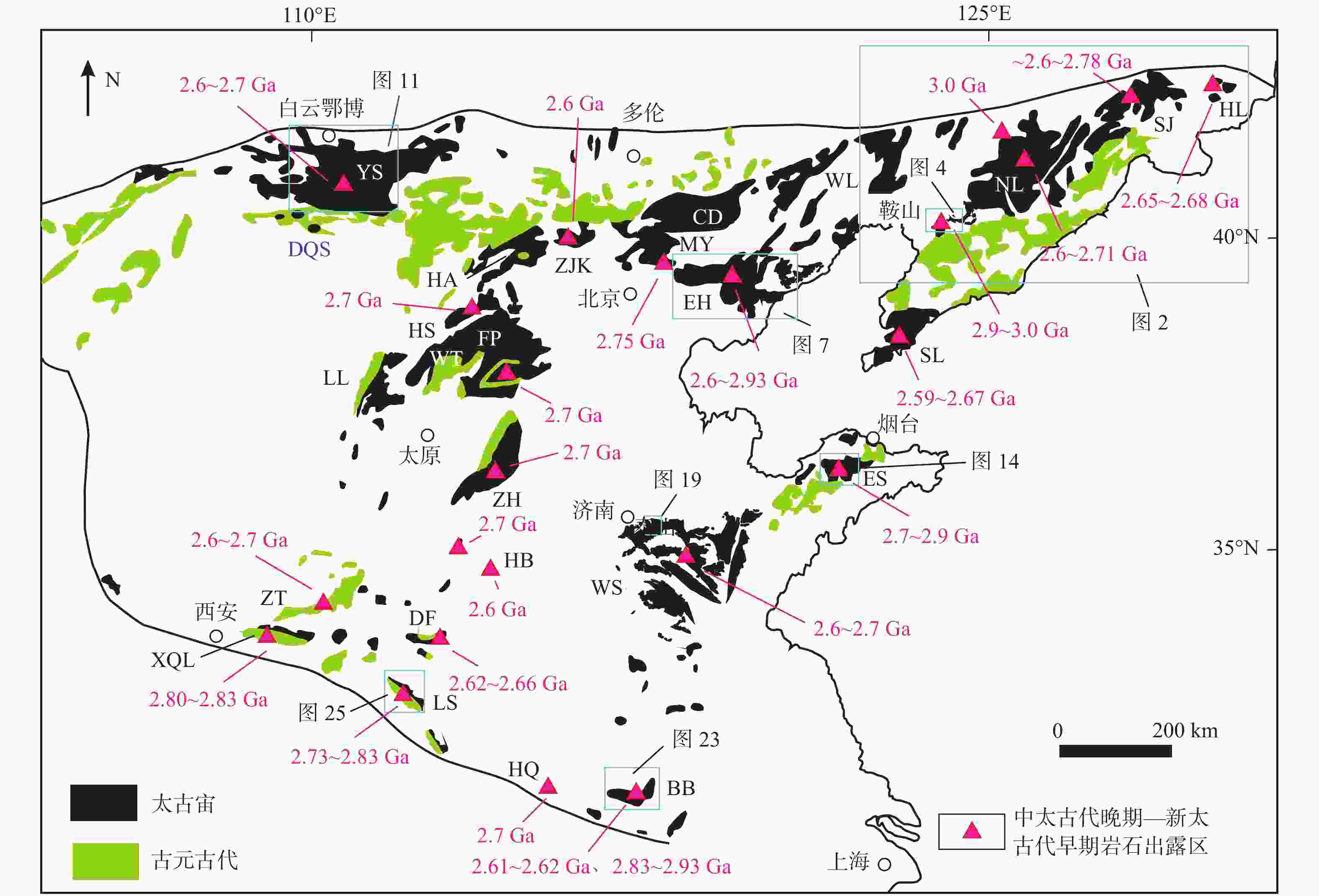
 下载:
下载:
